Late autumn is the best season for cycling. Recently, Beijing Municipal Bureau of Culture and Tourism, in collaboration with the governments of all districts in Beijing as well as Beijing Economic-Technological Development Area Management Committee, released 21 cultural tourism cycling routes themed "Roaming in Beijing" to citizens and tourists.
The 21 cultural tourism cycling routes have a total length of 730.8 kilometers, including four cross-district routes featuring the Central Axis, Peking Opera, etc., and 17 district-centered routes that reflect the characteristics of each district. These short- and medium-distance cultural tourism cycling routes are the missing pieces that bridge the gap between short-distance strolls and long-distance self-driving trips for the very first time. With "cycling + immersive experience" as the core and "culture + innovative conditions" as the link, these routes connect the dots of various new consumption scenarios, cultural sites with stories, Internet-famous sites, and knowledge-sharing spots, achieving multi-dimensional integration of cultural experiences, leisure and fitness, and cultural tourism consumption.
Beijing Municipal Bureau of Culture and Tourism also launched a new brand of cultural tourism called "Cycling Around Beijing" and put forward the slogan "Sightseeing While Cycling, Enjoy Being Young and Have Fun" to attract young consumers and guide residents and tourists to enjoy Beijing "in a slow pace". Such measures are aimed at stimulating the potential of cultural and tourism consumption and promoting the integrated development of culture, tourism, sports and commerce.
- Cycling Route1
- Cycling Route2
- Cycling Route3
- Cycling Route4
- Cycling Route5
- Cycling Route6
- Cycling Route7
- Cycling Route8
- Cycling Route9
- Cycling Route10
- Cycling Route11
- Cycling Route12
- Cycling Route13
- Cycling Route14
- Cycling Route15
- Cycling Route16
- Cycling Route17
- Cycling Route18
- Cycling Route19
- Cycling Route20
- Cycling Route21
- Cycling Route1 Introduction
- Cycling Route1 map
- Cycling Route1 route
- Cycling Route1 along
The dream of "Youthful China", as the greatest dream since modern times, has inspired countless progressive young people to embark on the journey of national revitalization. Today, the Chinese Dream of national rejuvenation and the dream of "Youthful China" can be traced to the same origin.
In the name of youth, the youthful cycling route pays tribute to the Awakening Age.
Tuesdays to Sundays: 09:00-12:00, 14:00-17:00
(last entry at 16:30)
All day
Wednesdasy to Sundays:
09:00-12:00 14:00-16:30
(last entry at 16:00)
Tuesdays to Sundays (closed on Mondays)
9:00-16:00
(ticketing stops at 15:30)
Mondays to Fridays: 09:30-18:00
09:00-17:00
(last entry at 16:00)
Closed on Mondays, except for public holidays
09:00-12:00,13:00-17:00
(last entry at 16:00)
Closed on Mondays

Planned route
Former Site of Jingbao Office (Former Residence of Shao Piaoping)—Guangyanggu Urban Forest Park—Former Residence of Li Dazhao (Beijing)—Beijing Luxun Museum—Zhengyang Bookshop—Red Building of Peking University—Former Site of New Youth's Editorial Department (Former Residence of Chen Duxiu)

Road condition
gentle bicycle lanes, with some sections of secluded hutong (alleys)

Target groups
all ages, with their own bikes or shared bikes

Length
about 12 kilometers

Suggested time to finish
about 3.5 hours
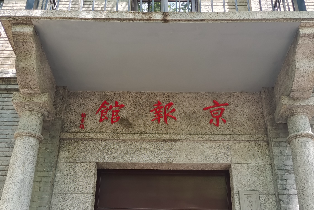
#
The overall building complex of the Former Site of Jingbao Office is well preserved. The Jingbao Office is comprised of a modern two-story wooden building, and a quadrangle, as part of its Editorial Department. Here, Shao Piaoping founded the famous newspaper Jingbao, which promoted the spread of early Marxism.
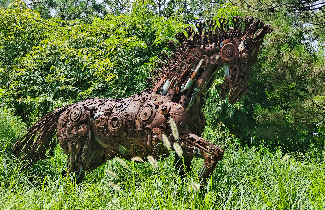
The Guangyanggu Urban Forest Park, covering an area of more than 30,000 square meters, is located at the northwest corner of the Caishikou Metro Station, less than one kilometer away from the Former Site of Jingbao Office.
Luxuriant trees in the park, together with the singing of insects and birds at times, make people almost forget that they are in a busy city.
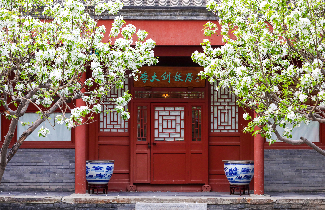
Cycling about three kilometers along the side road of Guang'anmen Inner Street, Changchun Street, Naoshikou Street and Wenhua Hutong, you will arrive at the Former Residence of Li Dazhao (Beijing).
The Former Residence of Li Dazhao (Beijing), located at No.24, Wenhua Hutong, Xicheng District, had been rented by Li Dazhao and his family for nearly four years from the spring of 1920 to January 1924. Li Dazhao is one of the main founders of the Communist Party of China (CPC). Some important meetings organized by the Beijing Communist Party in the early days were also held in Li Dazhao's study room.

Cycle three kilometers towards Fuxingmen Inner Street, Jinrong Street and Fuchengmen Inner Street, to reach the Beijing Luxun Museum.
The Beijing Luxun Museum was designed and renovated by Lu Xun after he bought it in the spring of 1924, and it is by far the most well-preserved residence of Lu Xun in Beijing. It still retains the original environment where Mr. Lu Xun lived at that time. More than 200 widely circulated works were created here.

After departing the Beijing Luxun Museum, cycle about 1.6 kilometers towards Fuchengmen Inner Street and Xisi South Street to arrive at the Zhengyang Bookshop characterized by Beijing's history and culture, where you can read books, pet cats and take a rest.
The Zhengyang Bookshop, full of the charm of old Beijing, boasts several time-honored fish basins picked by the owner himself from old houses in Qianmen Gate. It is worth a visit.
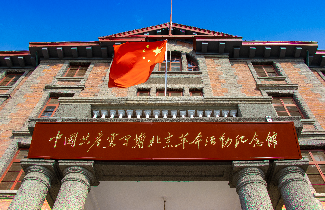
Traveling for about 2.9 kilometers along Xi'anmen Street, Wenjin Street and Jingshan Front Street, you can arrive at the Red Building of Peking University on Wusi Street. The route offers you pleasant scenery, such as the white pagoda in Beihai Park, corner towers of the Forbidden City and pavilions in Jingshan Park.
Built in 1918, the Museum of Early Revolutionary Activities of the CPC (Red Building of Peking University) was originally the site of Peking University's Administration Office, No.1 School (Liberal Arts) and Library. It once served as the base of the New Culture Movement, an important cradle of the May 4th Movement and the birthplace of the early Communist Party organizations in Beijing. Nowadays, here you can visit the exhibition themed the early revolutionary activities of the CPC in Beijing.

Cycling along Wusi Street and Beiheyan Street, you can arrive at the Former Site of New Youth's Editorial Department (Former Residence of Chen Duxiu), about 1.3 kilometers away from the Red Building of Peking University.
The Former Site of New Youth's Editorial Department (Former Residence of Chen Duxiu) is one of the main bases of the New Culture Movement and an important place for the early spread of Marxism in China. The Former Residence of Chen Duxiu, as a one-tier quadrangle, hosts the "Thematic Exhibition of New Youth in History" and "Thematic Exhibition of Chen Duxiu in Beijing". The two exhibitions detail Chen Duxiu's life in Beijing and the development of the magazine New Youth in Beijing.
- Cycling Route2 Introduction
- Cycling Route2 map
- Cycling Route2 route
- Cycling Route2 along
The Peking Opera is the quintessence of Chinese culture and an intangible cultural heritage of mankind. Known as the "National Opera", it is one of the most artistically charming and oldest operas in the treasure house of Chinese dramas. Since the Hui opera troupes coming to perform in Beijing in 1790, it has a history of more than 200 years. The Peking Opera art is the crystallization of traditional Chinese art, a treasure of national culture, and an important cultural symbol of Beijing. Strolling in Beijing and cycling with the theme of Peking Opera, you are invited to appreciate the elegance of National Opera of China.
Every day 10:00-22:00
All day
Everyday 10:00-18:00
Every day 09: 30-21: 30
Mondays to Sundays: 08:00-21:00
(last entry at 20:00)
Everyday 10:00-22:00
Tuesdays to Sundays: 09:00-11:30, 12:30-16:30 (last entry at 16:00)

Planned route
Zheng-Yi Temple Theater Peking Opera House—Landmark Stone Square for Cradle of Peking Opera—Beijing Fenglei Peking Opera Troupe—Tianleyuan Grand Theater—Pigment Guild Hall—Jixiang Theater—Mei Lanfang Memorial Hall

Road condition
gentle bicycle lanes, and some sections of secluded hutong (alleys)

Target groups
all ages, with their own bikes or shared bikes

Length
about 13 kilometers

Suggested time to finish
about 4.5 hours
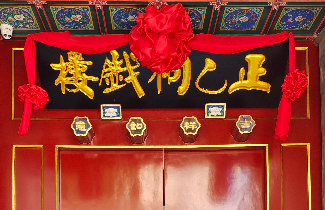
#
Located at No.220, Qianmen Xiheyan, the Zheng-Yi Temple Theater Peking Opera House is adjacent to the Tian'anmen Square to the east and Liulichang Cultural Street to the south. It was originally an ancient temple in the Ming Dynasty, with a long history of 300 years. The Zheng-Yi Temple Theater Peking Opera House, used to be the Bank Guildhall, is the oldest and basically well-preserved pure wood-structured theater in China. Known as the "living fossil of Chinese theaters", it has witnessed the birth, development and glory of Peking Opera performance art. Many artists of Peking Opera performed here. After more than 300 years, the Zheng-Yi Temple Theater Peking Opera House is still full of art and youth, demonstrating the development trend of multi-fusion and creating a new space for performing arts in the form of "operas in guildhall".

Cycling for 1.6 kilometers across small hutongs (alleys) of Xicheng District along Shejia Hutong, Yanshou Street, Tongzi Hutong and Shaanxi Lane, passing by the Liulichang East Street, to arrive at the Landmark Stone Square for Cradle of Peking Opera located near Zhushikou West Street.
Built in September 2016, the Landmark Stone Square for Cradle of Peking Opera is located next to the former residence of Ji Xiaolan in Dashilan Sub-district, Xicheng District. The Dashilan area was the foothold of Hui opera troupes coming to perform in Beijing more than 200 years ago, the center for Peking Opera training schools, and the gathering place for famous Peking Opera actors. In the past 200 years, many renowned Peking Opera masters such as Tan Xinpei and Mei Lanfang made names for themselves here. The "intangible cultural heritage" Peking Opera culture has also spread to the whole China and beyond, becoming the quintessence of Chinese culture.
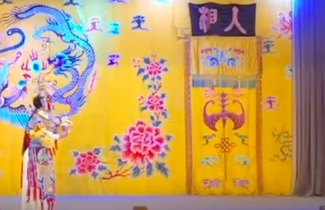
Bypassing Zhushikou West Street, cycling along the side road for about one kilometer and passing through Banzhang Hutong, you will arrive at the Beijing Fenglei Peking Opera Troupe.
Having been established for 82 years, the Beijing Fenglei Peking Opera Troupe has employed and cultivated many Peking Opera performers, and has created and performed many classic plays. In order to bring Peking Opera culture closer to the public, the troupe has been carrying out artistic activities to promote the roles in Peking Opera. Tourists can put on costumes and learn about "singing, recitation, acting and acrobatics" with Peking Opera performers. At the same time, the troupe also provides activities such as the Peking Opera parent-child interactive entertainment and Peking Opera salon.
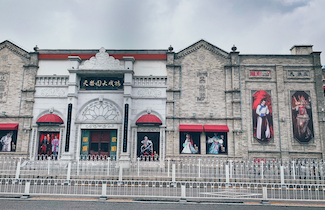
Cycling for about 1.4 kilometers from Banzhang Hutong to Yao'er Hutong, passing by Qianmen Street, the side road of Zhushikou East Street and Qianmen East Road, to reach the Tianleyuan Grand Theater.
The Tianleyuan Grand Theater is an old Beijing theater with a history of nearly 200 years. The theater witnessed the birth and development of Chinese Peking Opera, where Mei Lanfang made his debut, Cheng Yanqiu made a name for himself, and the Chongya Society, China's first Peking Opera school for females, was established. The reopened Tianleyuan Grand Theater has become a themed experience hall of Peking Opera. It not only presents the innovative Peking Opera play Debut incorporating new technologies, but also holds Peking Opera collection exhibitions with different themes, providing the audience with more cultural experience of Peking Opera.

Cycling for less than 500 meters along Xianyukou Street, Changxiang Santiao and Changxiang Wutiao, you can arrive at the Pigment Guild Hall in Qingyun Hutong.
The Pigment Guild Hall, also known as the Pingyao Guild Hall, was founded by pigment and tung oil merchants from Shanxi in the Ming Dynasty. It is one of the earlier commercial guild halls built in Beijing. After the renovation of the Pigment Guild Hall, the original look of the stage has been reproduced. Here, you can enjoy the Kunqu Opera, Hebei Clapper Opera and ancient opera arias.
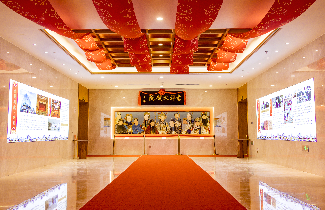
Return to the Xianyukou Street from Changxiang Wutiao, cycle north along Caochang Santiao, Zhengyi Road and Nanheyan Street, go east from Nankoudai Hutong passing by Wangfujing Street, and continue cycling north on Jiaowei Hutong all the way to Xitangzi Hutong, with a total cycling distance of about 3.3 kilometers. The Jixiang Theater is over there.
The Jixiang Theater, founded in 1906, formerly known as the "Jixiang Garden", is one of the famous century-old theaters in Beijing. The new Jixiang Theater is located on the 7th floor of Yintai in88 Building, No.88, Wangfujing Street. The new one, with a unique landscape, is a "sky theater" that combines traditional and modern styles. With more than 330 seats, the interior of the new theater is full of antique beauty. After re-opening, the new Jixiang Theater has become a high-end performance venue gathering masters of Peking Opera and Kunqu Opera, a base for inheriting, displaying and experiencing national quintessence, and a platform for multicultural activities.
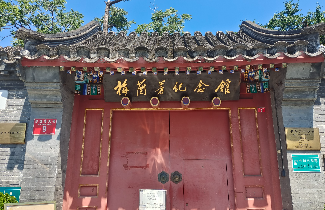
Bypass the Wangfujing Yintai, and cycle along Dong'anmen Street and Beiheyan Street to arrive at the Imperial City Wall Relics Park just beside the Beiheyan Street. You can enjoy sightseeing while cycling. Turning left at Di'anmen East Street, you will pass by the Lotus Market of Shichahai area and the north gate of Beihai Park. Cycle all the way through Di'anmen West Street to arrive at Deshengmen Inner Street which is not far away from the Mei Lanfang Memorial Hall. Along the 5.2-kilometer route, you can stop and go as you like, enjoying a comfortable and pleasant trip.
The Mei Lanfang Memorial Hall, a typical two-tiered quadrangle, was the residence of Mr. Mei Lanfang in the last 10 years of his life. Its front yard serves as an exhibition hall showing Mr. Mei's artistic career with a large number of photos and objects. The three north rooms in the backyard retain what they originally looked like. In the living room, there is hardwood furniture, a dressing mirror for exercising and pigeon whistles used by Mr. Mei. The inner room next to the living room is the sitting room, and the west wing room is set up as a showroom, which mainly shows the cultural achievements of Mr. Mei. The east wing room is specially set up as a video room to reproduce the artistic performances of Mr. Mei.
- Cycling Route3 Introduction
- Cycling Route3 map
- Cycling Route3 route
- Cycling Route3 along
Beijing's Central Axis means the symmetrical axis of buildings in the east-west layout of Beijing since it was called Dadu (capital city) in the Yuan Dynasty and Beijing City in the Ming and Qing dynasties.
Kublai Khan, the founder of Yuan Dynasty, first put forward the concept of building Central Axis, the length of which was about 3.8 kilometers at that time. After the expansion and renovation in the Ming and Qing dynasties, it was fixed at 7.8 kilometers long in total. Until the holding of 2008 Beijing Olympic Games, the Central Axis was extended northward to Beijing Olympic Forest Park, and its length became 25 kilometers.
Beijing's Central Axis has witnessed the urban development and changes of this ancient capital for more than 800 years, which determines the overall spatial pattern and social order of the city, and produces the unique magnificent order of Beijing. Therefore, it is deemed the core of urban development in Beijing.
Cycling on the most beautiful Central Axis and get a quick view of Beijing City!
All day
9:00-17:00 (last entry at 16:30), closed on Mondays (except for public holidays)
9:00-17:00 (last entry at 16:00), closed on Mondays (except for public holidays)
8:30-16:30 (last entry at 16:00)
Closed on weekends and public holidays
13:30-17:30 (ticketing stops at 16:30)
6:00-21:00

Planned route
Beijing Tianqiao Performing Arts Center—Temple of Agriculture (Beijing Ancient Architecture Museum)—Yongdingmen Gate—Beijing Museum of Natural History—Zhengyangmen Gate—Imperial Archive - Corner Towers of Forbidden City—Shichahai Area—Drum Tower and Bell Tower—Yuan Dadu City Wall Ruins Park—Beijing Olympic Park

Road condition
gentle bicycle lanes, with some sections of greenways in parks and secluded hutong (alleys)

Target groups
all ages, with their own or shared bikes

Length
about 22 kilometers

Suggested time to finish
about six hours
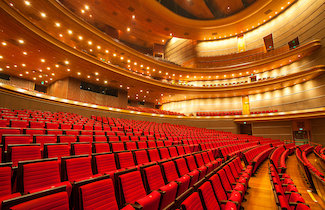
#
The Beijing Tianqiao Performing Arts Center is located on the west side of Nanzhongzhou Road, to the north of Yongdingmen Gate, with the Temple of Heaven in the west and adjacent to Qianmen Gate in the north. On the one hand, the center is engaged in planning art festivals, so as to build a vibrant cultural consumption place. On the other hand, it focuses more on popularizing art education and participation, so as to bring art into the life of the public and realize the fashionable lifestyle of "walking into the art center".
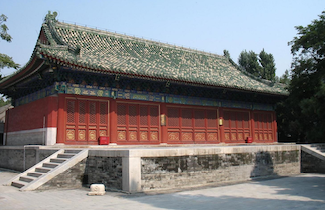
Cycling along Tianqiao South Street, Nanwei Road and Dongjing Road for less than one kilometer to arrive at the Temple of Agriculture.
Originally used to be a religious site for emperors to perform sacrifices to the God of Agriculture, the architectural complex of the Temple of Agriculture has gone through more than 400 years. The overall layout is basically complete, and the architectural construction characteristics and artistic style basically retain the features of the Ming Dynasty. Located inside the Temple of Agriculture, the Beijing Ancient Architecture Museum is the first themed museum in China that collects, studies and displays the history, art and technology of ancient Chinese architecture. In addition, the museum also houses its key highlight of the collections, namely the caisson ceiling of the Longfu Temple. Please do not miss it.
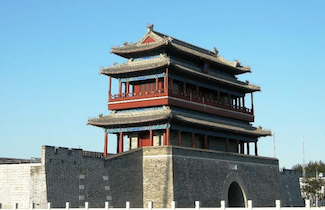
Cycling for about 1.8 kilometers through Dongjing Road, Nanwei Road and the side road of Yongdingmen Inner Street, you can arrive at the Yongdingmen Gate.
The Yongdingmen Gate is also known as Zhengyang Outer Gate, which means "eternal stability". Yongdingmen Gate Tower was initially built in the 32nd year of the Jiajing Period in the Ming Dynasty, which was the former front gate of the outer city of Beijing's old city wall in the Ming Dynasty, with magnificent architectural scale. The current Yongdingmen Gate Tower was rebuilt by Beijing Municipality in 2004 following the style of the Qianlong period. The main buildings include the gate platform, the archery tower and the enceinte, forming a complete city defense architectural system. Today, Yongdingmen Gate Tower is the southernmost landmark building on Beijing's Central Axis.
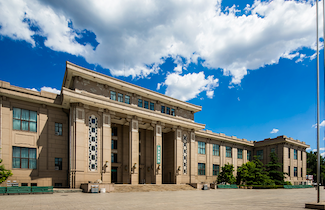
Cycling for about 1.6 kilometers from the side road of Yongdingmen Outer Street to Yongdingmen Inner Street, and then to Tianqiao South Street, you can arrive at the Beijing Museum of Natural History.
Established in April 1951, the Beijing Museum of Natural History was formerly known as the Preparatory Office of the Central Museum of Nature. It was officially named as the Beijing Museum of Natural History in 1962. The museum is the first large-scale natural history museum built by the New China independently, mainly engaged in specimen collection, scientific research and science popularization in the fields of paleontology, zoology, botany and anthropology. The basic exhibition of the museum takes biological evolution as the main line, showing biodiversity and its relationship with the environment and constructing a panoramic view of the occurrence and development of life on earth.
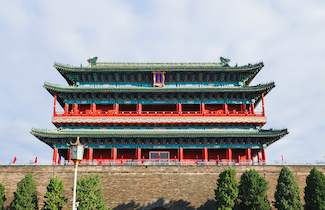
Cycling southward from Tianqiao South Street to Zhushikou, turning to Zhushikou East Street, and then continuing going southward along Qianmen East Road, with a total cycling distance of about 2.5 kilometers, you can arrive at the Zhengyangmen Gate.
The Zhengyang Gate, commonly known as Qianmen, is the main entrance to the inner city of Beijing in the Ming and Qing dynasties, with a history of more than 500 years. Among the gates of Beijing, the Zhengyang Gate is the most ceremonious in regulation, which is not only the embodiment of urban layout, military defense, etiquette system and architectural art in the late feudal society of China, but also an important carrier of the history and culture of old Beijing. The Zhengyang Gate is composed of the enceinte and archery tower in the south and the main building in the north, which is an important symbol of the southern Central Axis.
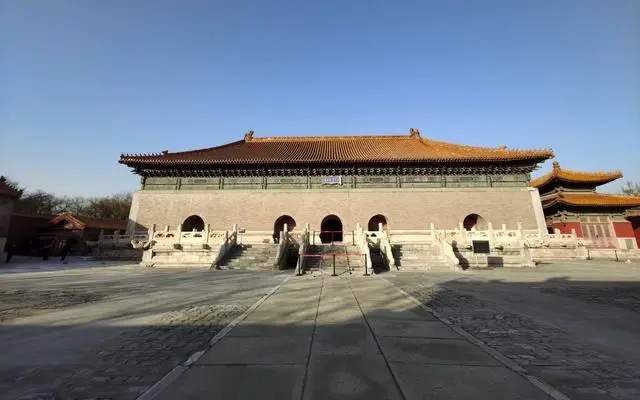
Riding along the east side road of the square, and passing by Tian'anmen Square, Dongchang'an Street and Nanchizi Street, with a cycling distance of about 1.5 kilometers, you can arrive at the Imperial Archive.
The Imperial Archive, originally named the Tower of the Divine Emperors and Archive of Official Documents, is located at No.136, Nanchizi Street, Donghuamen Sub-district, Dongcheng District. It was originally built in the 13th year of Jiajing Period in the Ming Dynasty (A.D. 1534) and was the national archives repository of the Ming and Qing dynasties of China. At present, it is the Ming and Qing archives showroom of The First Historical Archives of China. The Imperial Archive is divided into the southern yard and the northern yard, including the Main Building, Eastern Wing, Western Wing, Pavilion of the Imperial Slab and Entrance Gate. It is the most complete and oldest existing royal archives building complex in China, which comprehensively reflects the excellent tradition and technological achievements of archives protection in ancient China.
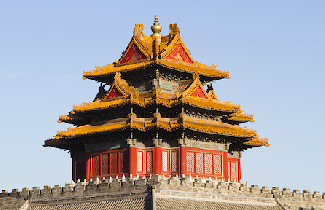
Coming out of the Imperial Archive, continue cycling for about 1.7 kilometers along Nanchizi Street and Beichizi Street to reach the Corner Towers of the Forbidden City.
There is an exquisite and ingenious corner tower on each of the four corners of the walls of the Forbidden City, which was built in the Ming Dynasty for more than 500 years. You can go to the Forbidden City Corner Tower Cafe to have a cup of "Emperor Kangxi's Favorite Chocolate", take a rest and relax yourself.
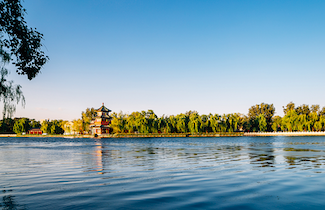
Continuing riding towards the direction of Jingshan East Street and Jingshan Back Street, and passing by Di'anmen Outer Street and Di'anmen Inner Street, with a total cycling distance of about 1.5 kilometers, you will arrive at Shichahai Area.
The surrounding area of Shichahai has been a bustling business zone of Dadu (as Beijing was then known) since the Yuan Dynasty. At that time, it was the endpoint of water transportation and was called as "Beijing's Ancient Port". There were restaurants, singing stages, stores and workshops everywhere along the waterfronts. At present, Shichahai is still a leisure resort, and the royal mansions and former residences in the surrounding hutong also bring endless Beijing flavor. Cyclists with excess physical energy can also take a ride around the Sanhai of Shichahai Area.
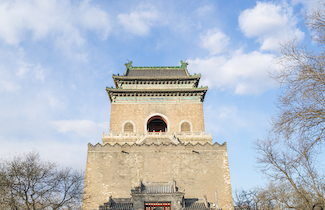
Cycling to the end of Di'anmen Outer Street, you will arrive at the Bell Tower and Drum Tower.
The Bell Tower and Drum Tower used to be the two tallest buildings on Beijing's Central Axis during the Ming and Qing dynasties of more than 500 years. As the time-telling center of capital Beijing in the Yuan, Ming and Qing dynasties, the Bell Tower and Drum Tower are landmark buildings in ancient capital city Beijing.
In the evening of Beijing in the past, with the sound of bells and drums, the ancient capital would experience a ceremonial dormancy until the sound of bells and drums again at 03:00 the next day, and the city gradually woke up. Now the second floor of the Drum Tower has been repaired and open to public, cyclists can stop here and pay a visit.
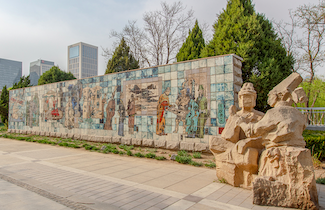
Ride along Jiugulou Street, Andingmen West Street and Gulou Outer Street for about 4.9 kilometers to the Yuan Dadu City Wall Ruins Park.
The total length of Yuan Dadu City Wall Ruins Park is nine kilometers. The park does not have the majesty and grandeur of the royal garden, nor the open space of the vast grasslands of the forest park, but it contains the ancient history of the founding of the capital Beijing. In 1276, the city wall of Dadu in the Yuan Dynasty was built, with a base width of 2.4 meters. To this day, only the ruins of the northern section of the West Earth Wall and North Earth Wall have been preserved, and the Yuan Dadu City Wall Ruins Park was built on this basis. It is the largest urban belt-shaped park in Beijing, with the largest group sculptures and artificial wetlands in Beijing downtown.
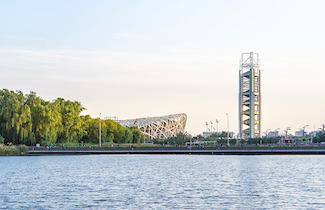
After seeing the charms of Yuan Dadu City Wall Ruins Park, crossing Beitucheng Road, then cycling northward along Beichen Road, you will arrive at Beijing Olympic Park.
Covering an area of 11.59 square kilometers, the Beijing Olympic Park is the extension of the traditional Central Axis of Beijing city, which means the continuation of Chinese history and culture. It includes the National Stadium (Bird's Nest), National Aquatics Center (Water Cube), National Speed Skating Oval (Ice Ribbon), and China National Convention Center. Home to forest parks, mountains and lakes, as well as a sunken garden nine meters underground, the park combines Chinese traditional architectural elements with modern architecture, and embodies the concept of "Green Olympics, High-tech Olympics and People's Olympics".
- Cycling Route4 Introduction
- Cycling Route4 map
- Cycling Route4 route
- Cycling Route4 along
The 2nd Ring Road of Beijing was completed and opened to traffic in September 1992. It is the first urban express ring road in China that is fully enclosed, fully interchanged, and has no traffic lights.
The 2nd Ring Road has been built around the old city of Beijing. The location of this ring road happens to be the ancient city wall of old Beijing. There are many high-rise buildings on both sides of the road, with various landscapes such as overpasses, gate towers and moats, showing the development of urban modernization in Beijing. The 2nd Ring Road not only serves the traffic function of Beijing, but also a model of the urban slow transportation system. At present, it is also an Internet-famous site for cycling enthusiasts.
Let us make a tour on the 2nd Ring Road!
Cycling along the 2nd Ring Road, you can visit the parks downtown and enjoy the natural scenery of Beijing city. Riding on the hutong, you will get a view of the historic architectural landmarks. While exploring the Internet-famous hutong, you can experience the cultural and artistic flavor that combines ancient and modern, Chinese and Western styles.
April 1 to October 31, 09:00-17:00 (ticketing stops at 16:30);
November 1 to March 31 of next year, 09:00-16:30 (ticketing stops at 16:00);
Closed on Mondays
Tuesdays to Sundays: 09:00-17:00(last entry at 16:30)
Closed on Mondays,
Tuesdays to Sundays, 08:30-17:00 (ticketing stops at 16:30)
April 1 to October 31, 06:00-22:00 (ticketing stops at 20:00, last entry at 21:00);
November 1 to March 31 of next year, 06:30-22:00 (ticketing stops at 20:00, last entry at 21:00);
April 1 to October 31, 06:00-22:00 (last entry at 21:00);
November 1 to March 31 of next year, 06:00-21:30 (last entry at 21:00);
April 1 to October 20, 07:30-18:00 (last entry at 17:30);
October 21 to March 31 of the next year, 07:30-17:00 (last entry at 16:30);
Whole year, 06:00-21:00 (last entry at 20:00)
All day in the whole year
All day in the whole year
13:30-17:30 (last entry at 17:00)
All day in the whole year

Planned route
Yonghe Lama Temple (North 2nd Ring Road)—Beijing Ancient Observatory (East 2nd Ring Road)—Beijing Ming Dynasty Wall Relics Park—Temple of Heaven (South 2nd Ring Road)—Taoranting Park - Daguanyuan (Grand View Garden)—Beijing Yingcheng Jiandu Waterfront Greenway (West 2nd Ring Road)—Yuetan Park—Shichahai Area (North 2nd Ring Road)—Drum Tower—Wudaoying Hutong

Road condition
gentle bicycle lanes, and some sections of secluded hutong (alleys)

Target groups
all ages, with their own or shared bikes

Length
about 35 kilometers

Suggested time to finish
about six to eight hours

#
The Yonghe Lama Temple, as a royal temple in the Qing Dynasty, is located at No.12, Yonghegong Street, Dongcheng District, Beijing. Emperor Yongzheng and Emperor Qianlong of the Qing Dynasty once lived here. In February 1981, it was opened to the public as a place for religious activities.
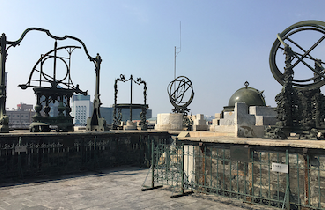
Cycling about 5.6 kilometers along Yonghegong Street, Dongzhimen Inner Street and East 2nd Ring Road, you will arrive at the Beijing Ancient Observatory.
The Beijing Ancient Observatory, founded in the seventh year of Zhengtong Period in the Ming Dynasty (A.D. 1442), is the royal observatory of the Ming and Qing dynasties. With a long history, well-preserved architecture, courtyard and complete equipment, the Beijing Ancient Observatory is an important place for cultural exchanges between China and the West in the late Ming and early Qing dynasties, enjoying a great reputation at home and abroad. At the Beijing Ancient Observatory, you can see eight exquisite Qing Dynasty astronomical observation instruments and the exhibition "Ancient Chinese Astronomy" to learn about the achievements of ancient Chinese astronomy and the history of astronomical exchanges between China and the West.

Departing the Beijing Ancient Observatory, cycling south for about 750 meters to arrive at the Beijing Ming Dynasty Wall Relics Park.
The Beijing Ming Dynasty Wall Relics Park starts from the southeast corner tower in the east and ends at the Chongwenmen Gate in the west. The 1.5-kilometer section of the city wall is one of the only two remaining Ming city walls in Beijing. The city wall was built in the 17th year of Yongle Period in the Ming Dynasty (A.D. 1419) and has a history of more than 600 years. It is an important symbol of the historical development of Beijing. The park is famous for the plum blossom festival held every year. In addition, the scenery has its own characteristics throughout the year, which is suitable for taking photos.
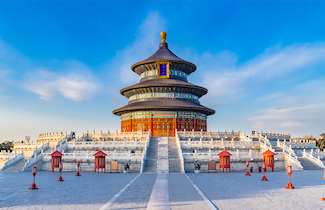
Coming out of the Beijing Ming Dynasty Wall Relics Park, cycling along the South Moat of Beijing, passing by the Guangqumen Bridge, Guangming Bridge and Zuo'anmen Bridge, heading towards the Yuyan Bridge and entering Tiantan East Road, with a total cycling distance of about 7.2 kilometers, you can see the Temple of Heaven.
The Temple of Heaven used to be the place where emperors of the Ming and Qing dynasties "made sacrifices to heaven" and "prayer for grains". It is round in the north and square in the south, meaning "round sky and square earth". The Temple of Heaven, first built in the 18th year of Yongle Period in the Ming Dynasty (A.D. 1420), has been expanded and rebuilt. As the largest heaven worship complex in the world, it is now a world cultural heritage and a key historical and cultural site under national-level protection.
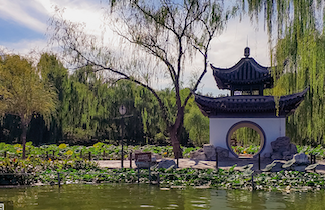
Coming out of the Temple of Heaven and cycling three kilometers westward, you will arrive at the Taoranting Park.
The Taoranting Park, built in 1952, is a famous historical and cultural garden that combines classical architecture and modern gardening art to highlight the "pavilion culture" of the Chinese nation. The whole park covers an area of 56.56 hectares, of which the water area is 16.15 hectares. The Taoran Pavilion is not only a famous pavilion in the Qing Dynasty, but also one of the four famous pavilions in China.
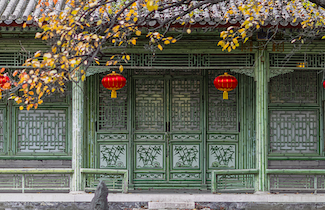
Riding west along the south moat for 2.5 kilometers, you will come to the Beijing Grand View Garden, an antique garden modeled on the classic novel A Dream of Red Mansions.
The Beijing Grand View Garden is located on Nancaiyuan West Street, Xicheng District, Beijing. It was built in 1984 and covers an area of 130,000 square meters. Due to the location selection of the TV series A Dream of Red Mansions for shooting, it was built based on the description in the novel and combination of the research of many Redologists (scholars of A Dream of Red Mansions). Now it has become a comprehensive tourist area focusing on film and television shooting services, with functions such as sightseeing, cultural entertainment, leisure and vacation.
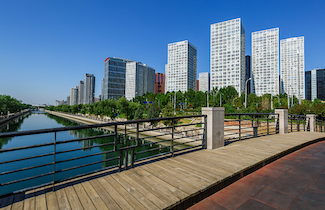
Coming out of the south gate of the Beijing Grand View Garden, cycling about 1.4 kilometers along You'anmen West street and Guang'anmen South Street, you can arrive at a section of waterfront greenway.
The Beijing Yingcheng Jiandu Waterfront Greenway is a cultural belt carrying the historical sites of the ancient capital of thousands of years, and it is also the largest belt-shaped leisure park in Beijing. Walking along the moat, you can see many scenic spots such as the Memorial Column for the Founding of Capital Beijing, Taohuawu (Peach Blossom Land), and Xuanyang Post Station.

Cycling all the way northward along the West Moat of Beijing, Guang'anmen South Street and Guang'anmen North Street, turning right at the side road of Xuanwumen West Street, then continuing cycling northward along Xibianmen Inner Street and Xibianmen Outer Street and passing by Nanlishi Road, with a total cycling distance of about 4.5 kilometers, you will arrive at the Yuetan Park.
The Yuetan, formerly known as the "Temple of the Evening Moon" is one of the five temples in Beijing, which was built in the ninth year of Jiajing Period in the Ming Dynasty (A.D. 1530). The ancient buildings such as the Bell Tower, Holy Gate and Holy Warehouse are well-preserved. There are many other scenic spots in the park, such as the Tianxiang Yard, Shuangxin Pavilion and Lanyue Pavilion.
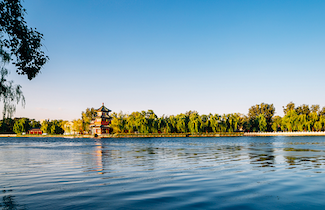
Coming out of the Yuetan Park, cycling about five kilometers towards the Fuchengmen Bridge, Xizhimen Bridge and Deshengmen West Street, you can reach the vicinity of Jishuitan, where the Shichahai Area is located. There are Xihai, Houhai, Qianhai and Xiaodaobibo (Island with Blue Waves), as well as former residences of celebrities. It is a good place to relax and enjoy the scenery.
Shichahai Area is located in Xicheng District, adjacent to Beijing's Central Axis. With a water area of 336,000 square meters, it is not only an open scenic spot with open surface water in the inner city of Beijing, but also the largest and most well-preserved historical block in Beijing. Since the Qing Dynasty, Shichahai has become a place for amusement and cool off in summer, and is one of the scenic spots in Yanjing (as Beijing was then known). The scenic spot, with beautiful landscape, is known as the "Water Town of North China". With perfect tourism forms, ancient cultural shops, snack streets and bars, it is one of the busiest cultural streets in Beijing.
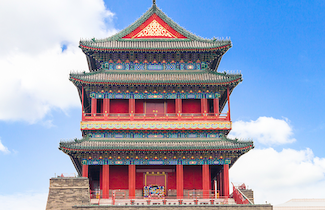
After sightseeing in Shichahai Area, cycling about 800 meters along Gulou West Street, you can pay a visit to the Drum Tower.
Beijing, the city of great antiquity, has the Bell Tower in the north and Drum Tower in the south, respectively at the front and the end of Di'anmen Street—on the central axis of the imperial city, which are echoed by the Jingshan Mountain in the south. As the time-telling center of capital Beijing in the Yuan, Ming and Qing dynasties, the Bell Tower and Drum Tower are the landmark buildings in ancient capital city Beijing.

Then cycling 2.5 kilometers along Guloudong Street and AndingmenWest Street, you can enter the Wudaoying Hutong. utong
The Wudaoying Hutong is located on the east side of the Andingmen Overpass in Dongcheng District, which starts from Yonghegong Street in the east and ends at Andingmen Inner Street in the west, with a total length of 632 meters. It is an Internet-famous hutong in Beijing. There are many cafes, bars and specialty restaurants in this hutong, which fully meets the leisure needs of young people to have fun in sightseeing, strolling, eating and shopping. Here you can always find something different and fully personalized.
- Cycling Route5 Introduction
- Cycling Route5 map
- Cycling Route5 route
- Cycling Route5 along
Dongcheng District is historical, cultural and artistic. Let us traverse the 700-year history of Dongcheng District, search for the beauty of the city and listen to the story behind it.
The 22-kilometer cycling spends 5.5 hours. This route takes "cycling + immersive experience" as its core, connecting new consumption scenes such as the Internet-worthy places in Dongcheng District, cultural landmarks and humane historical sites. It also unlocks cultural places with stories behind, Internet-famous locations, and blocks with unique charm of Dongcheng District.
Tuesdays to Sundays: 09:00-11:30; closed on Mondays
All day
All day
08:30-16:30, closed on weekends and public holidays
All day
Peak Season (April 26-October 25): 09:30-17:30
Off Season (October 26-April 25): 09:30-16:30
All day

Planned route
Shijia Hutong Museum—Wudaoying Hutong—Chengxian Street—Bell Tower and Drum Tower—Imperial Archive—Wangfujing Street—Dasein Youlan Hotel

Road condition
gentle cycle lanes, and some sections of secluded hutong (alleys)

Target groups
all ages, with their own or shared bikes

Length
about 22 kilometers

Suggested time to finish
about 5.5 hours

#
The Shijia Hutong Museum is the first museum specializing in Hutong culture in Beijing, which displays a miniature of 130 Beijing courtyards and more than 70 kinds of sounds once existing in hutong such as "Zhenjingrun (the sound from iron sheets, indicating the coming of knife-sharpening vendor)" and "Huchengzi (the sound from string bells, indicating the coming of herbalist)". The Shijia Hutong Museum is a very good place to learn about ordinary people and ordinary lives in Beijing. What the museum exhibits serves to tell the story of hutong for visitors.

Cycling about 6.6 kilometers all the way northward along Wusi North Street, passing by the Yonghe Lama Temple, a famous Tibetan Buddhism temple, then going several hundred meters westward, you will arrive at the Wudaoying Hutong.
Along the road from Dongsi stand traditional Chinese buildings and decorations of Dongcheng in recent two years. After entering from Chengxian Street, you can see the Imperial College and Confucian Temple, and here is the Demonstration Area of Beijing's Slow Transportation System. Wudaoying Hutong, parallel to Chengxian Street, is now a niche artistic and entertainment street in Beijing.
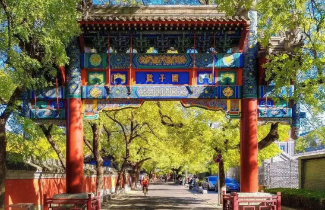
Cycling southward through Wudaoying Hutong, you will enter the Chengxian Street.
The Chengxian Street Scenic Area, located in Andingmen, Dongcheng District, is an east-west directional hutong and one of the few existing ancient streets in Beijing. The Chengxian Street, with rich cultural deposits, is home to famous Confucian Temple and the Imperial College.
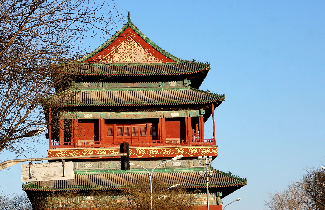
Cycling 3.6 kilometers all the way westward through Fensiting Hutong and Beijing GULOU Hospital of Traditional Chinese Medicine, you will arrive at the Bell Tower and Drum Tower, which is a landmark at the northern end of Beijing's Central Axis.
The Bell Tower and Drum Tower of Beijing are the models of Chinese ancient urban bell towers and drum towers. Scaled-down architectural models and multimedia films are used to show the audiences the architectural renovation history, architectural details and cultural connotation of Drum Tower and Bell Tower. In a simple way, the audiences are guided to understand the ancient architectural knowledge of Bell Tower and Drum Tower. As the endpoint at the north of Beijing's Central Axis, this scenic spot is an unmissable Internet-famous location.
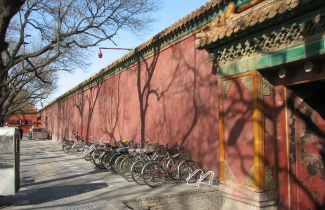
Continuing cycling about six kilometers southward, passing by the bustling Shichahai Area, the beautiful Jingshan Park and the exquisite Northeast Corner Tower of Forbidden City, and then riding all the way southward along Nanchizi Street, you will arrive at the Imperial Archive.
The Imperial Archive, also named the Archive of Official Documents, is located at the south entrance of Nanchizi Street to the east of Tian'anmen Square in Beijing. It was the national archives repository of the Ming and Qing dynasties of China.
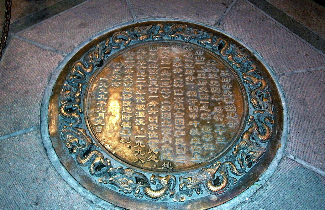
Continuing cycling 2.3 kilometers, passing by Beiwanzi Hutong and Datianshuijing Hutong, you will arrive at the famous commercial street—Wangfujing Street.
Here you can have a look at the "Well" in Wangfujing (Prince's Mansion Well). Visitors can also take pictures at the Wangfujing Pedestrian Street.
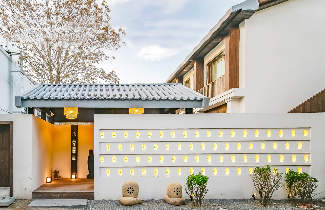
After passing through the busy commercial street and cycling about three kilometers, you will reach the destination of this riding journey—Dasein Youlan Hotel.
The Beijing Dasein Youlan Hotel is located in Bensi Hutong which was built in the Ming Dynasty with more than 700 years of history. In the shape of a real square, the courtyard was designed and retrofitted by the master designer of the Water Cube with black bricks and grey tiles.
- Cycling Route6 Introduction
- Cycling Route6 map
- Cycling Route6 route
- Cycling Route6 along
Ride for kilometers to catch a glimpse of the city's history of thousands of years.
Depart from Tanxi Shengjing (a scenic spot) in the northwest of Shichahai, and ride along the northern section of the Central Axis, and you will first pass by the majestic Jingshan Park, then head all the way west. The pagodas of the Yuan Dynasty, the palaces of the Ming Dynasty, and the courtyards of the Qing Dynasty, as well as the ancient towers amidst beautiful hills and clear waters, jump into your eyes one by one. Riding south along the red wall of Yuetan Park, you will reach the Capital Museum. By visiting the Capital Museum, you can learn about the history of Beijing. After seeing the thousand-year-old Liao Pagoda at the Tianning Temple, ride along the moat to look up at Yingcheng Memorial Column and the Capital Memorial Tower. Keep riding along the moat, and you will arrive at Xiannongtan Park built on the southern section of the Central Axis.
09:00-17:00
(Closed on Mondays)
All day
April 1 to October 31:
6:00-21:00
(Last entry at 20:30);
November 1 to March 31:
6:30-20:00
(Last entry at 19:30)
9:00-16:30
(Last entry at 16:00)
Closed on Mondays
All day
(Last entry at 16:00)
Closed on Mondays
(Except statutory holidays)
9:00-16:00
Reservations required for entries
All day
9:00-17:00
(Last entry at 16:30)
Closed on Mondays

Planned route
Guo Shoujing Memorial Hall → Wanning Bridge → Jingshan Park → Baita Temple → Yuetan Park → Capital Museum → Tianning Temple → Jinzhongdu Ruins Park (Yingcheng Memorial Column, Capital Memorial Tower) → Xiannongtan Park

Road condition
flat bicycle lanes alongside some sections of secluded alleys

Target groups
all ages, with their own bikes or shared bikes

Length
about 20 kilometers

Suggested time to finish
about five to six hours
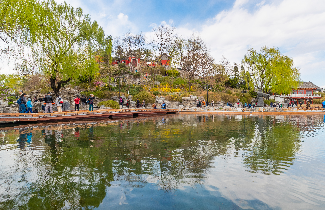
Guo Shoujing Memorial Hall, located in Huitong Temple on the north shore of Xihai Lake in Shichahai, was established to commemorate Guo Shoujing, an outstanding scientist in the Yuan Dynasty of China.
Pass through the beautiful Xihai Wetland Park, and climb up the hill on the shore, you can learn about the life of this scientific giant in the four permanent exhibition halls of the memorial hall, especially his important role in the planning and construction of the water system in the capital of the Yuan Dynasty and the opening of the Beijing-Hangzhou Grand Canal.
Following scientific curatorial concepts and making full use of well-designed graphic display boards, physical models, sand maps, etc., to provide visitors with all-around visiting experiences. In addition, the Memorial Hall adopts multimedia technologies to introduce the technical details of certain key nodes such as the planning of the water system, diverting water from the Baifu Spring, digging the Tonghui River, and completing the final connection of the Beijing-Hangzhou Grand Canal, visually presenting his scientific and technological achievements and the excellence of his mentality. You can also take the challenge of "Sailing Against the Current" in the Tonghui River, as you think about the past and future of the Grand Canal, to enjoy such a pleasant time of seeking knowledge beside the noisy 2nd Ring Road.
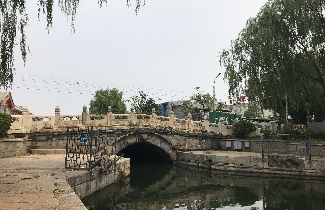
Ride along Deshengmenxi Street, and go southeastwards by way of Gulouxi Street, to reach Wanning Bridge.
Wanning Bridge, located in Di'anmenwai Street, Xicheng District, was built in the 22nd year of the Zhiyuan Period of the Yuan Dynasty (1285 AD). The stone bridge from the Yuan Dynasty strides over the estuary where Shichahai's water flows into the Yu River, and was the starting point of the Grand Canal in the Yuan Dynasty. A World Cultural Heritage sign for the Grand Canal stands next to the bridge.
On the stone revetments on both sides of the bridge, there is a beast-shaped sculpture on each of the four ends. Serving as the dividing points of the river, these stone beasts lie on the edges of the banks, as if they were looking at the bridge holes. The two sculptures on the east side of the bridge lie on the edge of the eastern bank, with their heads sticking out, posing as if they were looking at the water from the bank. Because they are on the lower side of the river, it looks as if they are looking at the water through the bridge holes. The two to the west of the bridge have their heads sticking out. Their claws with suction cups are grasping the vertical wall of the bank, with one side of the body of each hanging outside the bank, signifying that they have a good understanding of the water and will protect the river from floods.

Ride southwards from Wanning Bridge, and you can reach Jingshan Park via Jingshanhou Street. Those who want to climb Jingshan Hill can enter the park from the east gate or west gate, and go up the stair near either of the gates.
Jingshan Park is located at the central point of the north-to-south Central Axis of the inner city of Beijing. It was the back garden of the imperial palaces of the Yuan, Ming and Qing dynasties, and was once the highest point in the center of Beijing. Opened to public in 1928, it was designated as a key cultural and historical site under the municipal-level protection in Beijing in 1957. It was listed as a cultural and historical site under national-level protection in 2001, and became a national AAAA-level scenic area. It was rated as a Boutique Park of Beijing in 2005. There are tall old trees, uniquely beautiful peaks, majestic palaces, a wide variety of peonies, and rich cultural activities. There are five pavilions on Jingshan Hill, with Wanchun Pavilion of the central peak located at the commanding height of Beijing's Central Axis. Walking all the way up at Wanchun Pavilion, you can have a bird's view of the whole Forbidden City and the Central Axis. The charm of the neat and symmetrical layout, and the magnificence of the palace buildings are all taken within one glance.
The park used to be an important place for ancestor worship and remembrance for the emperors in the Qing Dynasty. Historical and cultural relics such as Shouhuang Hall, Guande Hall, Huguo Zhongyi Temple, and Qiwang Tower all symbolize strongly the culture of root-seeking and ancestor worship. The park is also a renowned place for the inheritance of the Chinese culture of filial piety.
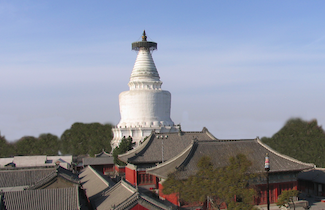
After visiting Jingshan Park, you can go westwards via Jingshanqian Street, Beihai Bridge, and Xi'anmen Street. Turn north after seeing the brick pagoda, and then turn left. After passing by Xisinei Street and Fuchengmennei Street, you will arrive at Baita Temple.
Baita Temple is located in Miaoying Temple on the north side of Fuchengmennei Street. It is commonly known as the "White Pagoda Temple" because there is a white pagoda inside. It is a national key protected cultural relic. The temple was built in the the 8th year of the Zhiyuan Period of the Yuan Dynasty (AD 1271), and was originally named Dashengshou Wan'an Temple. It was burned in the 28th year of the Zhizheng Period (1368 AD). In the 8th year of the Xuande Period in the Ming Dynasty (1433 AD), the temple was rebuilt and renamed as "Miaoying Temple". Most of the buildings in the temple were built in the Qing Dynasty. Only the White Pagoda survived the fire and is a legacy of the Yuan Dynasty. It has been standing for more than 750 years.
The White Pagoda of Miaoying Temple is an important symbol of the Yuan Dynasty, and it is the earliest and largest Tibetan Buddhist pagoda in China. Since Nepalese craftsman Anige participated in the design and construction, it is also a historical witness to the friendship and cultural exchanges between the peoples of China and Nepal.
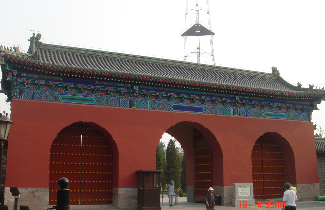
Continue westwards, go southwards via Jinrong Street, and then pass through Wudinghou Street and the side road of Yuetanbei Street. Yuetan (Temple of the Moon Park) is over there.
Yuetan Park is located on the west of Nanlishi Road and on the south of Yuetanbei Street, Xicheng District. Formerly known as "Xiyue Altar", it is one of the five altars in Beijing. It was built in the 9th year of the Jiajing Period in the Ming Dynasty (1530 AD), and was the place where the emperors of the Ming and Qing dynasties offered sacrifices to the Night God (the moon) and the gods of the constellations on the day of the autumn equinox. It is now a key historical and cultural site under national-level protection. Yuetan Park covers an area of 8.12 hectares and is divided into two parts, namely the South Park and the North Park. The North Park is characterized by ancient buildings with red bricks and green tiles and regular roads, while the South Park is a natural landscape garden composed of mountains, rocks, pools, and winding roads.

Head westwards from Yuetanbei Street to Sanlihedong Road, turn south, and cross Fuxingmenwai Street, and you will see a majestic building which is the Capital Museum.
The Capital Museum is a grand, modernized museum commensurate with Beijing's status as a "historical and cultural city", a "cultural center" and an "international metropolis", with magnificent architecture, rich exhibitions, advanced technologies, and refined functions. The exhibitions in the new hall mainly feature the items collected over the years and the cultural relics unearthed in Beijing, modernized and with unique Beijing characteristics, by absorbing the latest research results on history, cultural relics, archaeology and related disciplines, and drawing on the successful experience of museums both in China and other countries.
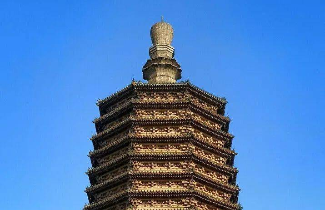
Continue southwards from Baiyun Road on the west side of the Capital Museum, turn east after crossing the Baiyun Bridge, and you will arrive at the Pagoda of Tianning Temple at the southwest end of Tianning Temple Bridge.
The Pagoda of Tianning Temple is located on the west side of Binhe Road, Guang'anmen, Xicheng District. It is an octagonal 13-story solid brick pagoda with dense eaves. The pagoda presents the architectural style of the brick tower with dense eaves in the Liao Dynasty in terms of overall shape and local techniques, and is an important example for studying the ancient Chinese Buddhist pagodas. At the same time, the pagoda is an important basis for determining the geographical location of the site of Nanjing City in the Liao Dynasty. The whole pagoda is elegant and straight in style, tall and majestic in shape, reflecting the superbness of the architectural art in the Liao Dynasty.

Ride southwards via the side road of the 2nd Ring Road, turn east after crossing the Baizhifang Bridge, then go southwards via Guang'anmennan Street, and you will reach Jinzhongdu (which means "Zhongdu City of the Jin Dynasty) Ruins Park.
Jinzhongdu Ruins Park is located at the northeast corner of Caihuying Bridge, covering an area of about five hectares. In the long and narrow park, five scenic spots are set up from south to north, named "Glance of the Gate Platform", "Construction of the Capital City", "Nomadic Jurchens", "Main Entrance Square", and "Xuanyang Post Station". There is a greenway next to the river, with green vegetation planted on both sides. Other facilities include pavilions and footpaths. There, you can exercise, sing, dance, and read. The beautiful environment and the fresh air make it an excellent place for leisure and entertainment for the nearby residents.

Go eastwards along the inner side of the South Moat, then pass by Daguan Garden and Taoranting Park, and you will arrive at Xiannongtan Park.
Xiannongtan Park was first built in the 18th year of the Yongle Period in the Ming Dynasty (AD 1420). It was originally named the "Shanchuan Altar". Its general form took shape during the Jiajing Period (AD 1522-1566) of the Ming Dynasty, and underwent large-scale reconstruction during the Qianlong Period (AD 1736-1796) of the Qing Dynasty. It is the place where the emperors of the Ming and Qing dynasties offered sacrifices to the God of Agriculture and held plowing ceremonies. Its Taisui Hall is a huge single building built in the 18th year of the Yongle Period in the Ming Dynasty (AD 1420), which is now Beijing Ancient Architecture Museum.
- Cycling Route7 Introduction
- Cycling Route7 map
- Cycling Route7 route
- Cycling Route7 along
Beijing is a "Dual Olympic City". Cycle in Chaoyang District and let us feel the sports spirit of perseverance and passion as well as live up to and carry forward the Olympic spirit.
March 1-October 31:
Monday to Sunday:
November 1- February 28: Monday to Sunday: 7:00-20:00
9:00-17:00 (last entry at 16:00)
Closed on Mondays
Tuesday to Sunday: 9:30-17:00 (last entry at 16:30)
Closed on Mondays ( except for statutory holidays), Lunar New Year's Eve, Lunar New Year's Day, and the second day of the lunar new year,
Monday to Sunday
09:00-20:00
08:30-16:00
Closed on Mondays
Daytime: 09:00-17:00
(last entry at 16:30)
Night: 17:00-22:00
(last entry at 21:00)
March 15-November 15:
6:00-21:00 (closed at 22:00)
November 16-March 14 next year:
06:00-20:00 (closed at 21:00)
January 1-December 31
Daytime: 9:00-19:00 (last entry at 18:00)
Night: 18:30-21:30 (last entry at 20:50)
January 1-December 31
Monday to Sunday
9:00-18:00 (last entry at 18:00)

Planned route
Yuan Dadu City Wall Ruins Park - Museum of the Communist Party of China - China Science and Technology Museum - National Speed Skating Oval (Ice Ribbon) - Beiding Niangniang Temple - Beijing Olympic Tower - Olympic Forest Park - National Stadium (Bird's Nest) - National Aquatics Center (the "Water Cube" and "Ice Cube")

Road condition
gentle bicycle lanes

Target groups
all ages with their own bikes or shared bikes

Length
around 19 kilometers

Suggested time to finish
around seven hours

#
Located in Shaoyaoju, Chaoyang District, the Yuan Dadu City Wall Ruins Park is built on the Yuan Dadu Tucheng Ruins and is a modern urban relics park that integrates the protection of historical relics, the leisure and recreation of citizens and the improvement of ecological environment.
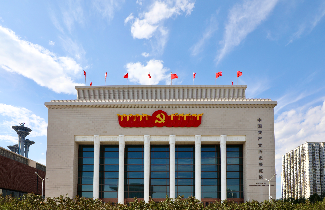
Cycling along Beitucheng East Road, Beichen Road, side road of North 4th Ring Middle Road, Anhui Bridge and Beichen East Road for around 6.2 kilometers, you will arrive at the Museum of the Communist Party of China, a top landmark in tribute to the epic history of the Communist Party of China.
Located on Beichen East Road, Chaoyang District, the Museum of the Communist Party of China is a permanent exhibition hall that panoramically showcases the glorious course of the Communist Party of China with the epic party history as the main clue.
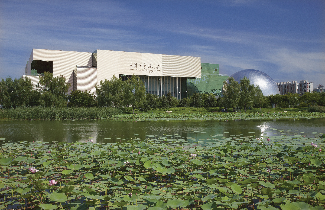
The China Science and Technology Museum is 490 meters away from the Museum of the Communist Party of China. You will arrive at this site after cycling all the way north on Beichen East Road.
Located on Beichen East Road, Chaoyang District, the China Science and Technology Museum is China's only state-level comprehensive museum themed science and technology and a large-scale infrastructure for science knowledge popularization. The museum has five themed exhibition halls, a public exhibition space and four special-effect cinemas.
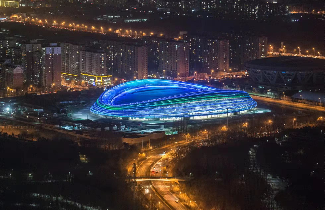
Cycling along Kehui South Road and Lincui Road from the China Science and Technology Museum for around 3.1 kilometers, you will arrive at the National Speed Skating Oval where you can feel the charm of ice and snow sports.
Known as the "Ice Ribbon", the National Speed Skating Oval is located in the central area of Beijing Olympic Park. It is the only newly built speed skating arena for the 2022 Beijing Winter Olympics and constitutes the iconic venues of the "Dual Olympic City" with the Bird's Nest and the Ice Cube.
The Ice Ribbon is the first speed skating arena in the history of the Winter Olympics that uses carbon dioxide as the refrigerant. As the venue for speed skating competitions during the 2022 Beijing Winter Olympics, 14 gold medals are competed here, making this venue the one awarding the largest number of gold medals during the 2022 Beijing Winter Olympics.
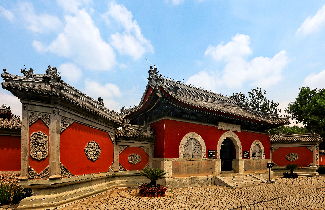
Cycling along Lincui Road, Kehui Road, Lincui East Road, Kehui South Road, and Beichen West Road from the National Speed Skating Oval for around 4.1 kilometers, you will arrive at the Beiding Niangniang Temple, one of the "Five 'Dings' (representing the five temples in the east, west, south, north and middle of Beijing) and Eight Temples".
Located on Beichen Road, Chaoyang District, the Beiding Niangning Temple is the iconic building at the north end of the northern extension of Beijing's Central Axis and is also one of the "Five 'Dings' and Eight Temples" in Beijing.
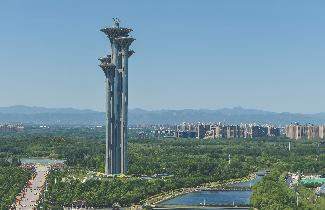
Cycling along the side road of Beichen West Road and Kehui South Road for around 2.5 kilometers, you will arrive at the Beijing Olympic Tower.
Located in the central area of the Beijing Olympic Park, the Beijing Olympic Tower is the commanding height of the park. The tower body is constituted of five independent towers with their height ranging from 186 meters to 246.8 meters. Designed with the concept of "the tree of life", the towers symbolize that the tree of life thrusts up from the concrete ground naturally with its branches spreading all around from the top of each tower, thus forming the shape of a tree crown. The five towers of different heights soaring into the sky presents different shapes to the tourists, showing the vigorous and positive spirit embodied in the Olympic Rings.

Cycling for 490 meters from the north of Beijing Olympic Tower and moving through Kehui Road, you will arrive at the south gate of the south area of Olympic Forest Park.
Located in the northern part of the Beijing Olympic Park and occupying a total land area of 6.80 sqm, the Olympic Forest Park is a comprehensive and super large-scale ecological urban park which extensively applies low carbon technology. The south park is dominated by natural landscape while the north park mainly offers tourists natural dense forest with rustic charm.
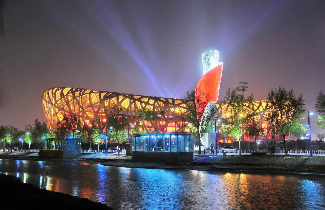
Cycling along Kehui South Road, Hujing West Road, and National Stadium North Road for around 1.3 kilometers, you will arrive at the small square on National Stadium North Road. This route offers picturesque lake scenery and is the best choice for cyclists. Walking into the Beijing Olympic Park through the No.6 Security Check Point and all the way to the south, you will arrive at the National Stadium and National Aquatics Center.
The National Stadium, also known as the "Bird's Nest", is situated in the central area of the Beijing Olympic Park. As the main venue of the 2008 Beijing Olympic Games, it can accommodate 91,000 audiences. In 2008, the stadium served as the venue for the opening and closing ceremony of the 2008 Beijing Olympics and Paralympics, the Olympic track and field competitions, the final of the men's Olympic football match, and the Paralympic track and field competitions, witnessing the awarding of 208 gold medals. The National Stadium is also the venue for the opening and closing ceremony of the 2022 Beijing Winter Olympics and Paralympics.
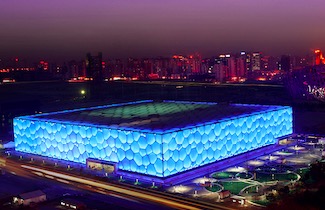
#
The National Aquatics Center, also known as the "Water Cube" and the "Ice Cube", is located in the central area of the Beijing Olympic Park. It is the venue for the swimming, diving and synchronized swimming competitions of the 2008 Beijing Olympic Games and also the arena for the swimming competitions of the 2008 Beijing Paralympic Games, witnessing the awarding of 182 gold medals. During the 2022 Beijing Winter Olympics and Paralympics, it was transformed into the "Ice Cube" as the venue for the Winter Olympic curling and Winter Paralympic wheelchair curling competitions, witnessing the awarding of four gold medals.
- Cycling Route8 Introduction
- Cycling Route8 map
- Cycling Route8 route
- Cycling Route8 along
During the 29-kilometer-long leisure ride around Haidian District, you can feel the charm of sci-tech innovation.
9:00-16:30
(Closed on Mondays)
10:00-19:30
NCL North Area; NCL Children's Library
Tuesday to Sunday
9:00-17:00 (Closed on Mondays)
NCL Ancient Books Library:
Tuesday to Saturday
9:00-17:00 (Closed on Mondays and Sundays)
8:30-11:30
14:00-17:00
9:00-11:00
14:00-16:00
9:00-17:00 (Last entry at 16:30)
Closed on Mondays (except for statutory holidays)
October 16 to March 15 next year
7:00-17:30
March 16 to April 30; September 1 to October 15
7:00-18:00
May 1 to August 31
7:00-19:00
April 1 to October 31
06:30-20:00
(Last entry at 18:00)
November 1 to March 31 next year
(Last entry at 17:00)
8:00-22:00

Planned route
Beijing Stone Carving Art Museum - Capital Indoor Stadium - National Library of China - Beijing Institute of Technology - Peking University - Tsinghua University - Tsinghua University Art Museum - Yuanmingyuan Park - Summer Palace - Wukesong Arena (Cadillac Arena)

Road condition
bicycle lanes

Target groups
all ages with their own bikes or shared bikes.

Length
about 29 kilometers

Suggested time to finish
one day
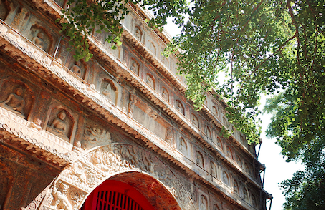
#
As a national Grade Ⅲ museum in China, the Beijing Stone Carving Art Museum is a themed museum committed to the collection, research and display of stone carving antiques all over Beijing.
The displayed antiques in the museum systematically showcase the stone carving culture of Beijing.

Cycling along Wutasi Road for around one kilometer to Zhongguancunnan Street, you will arrive at the Capital Indoor Stadium.
The Capital Indoor Stadium served as the venue for short track speed skating and figure skating competitions during the 2022 Winter Olympics. The key project highlighting the concept of "High-tech Winter Olympics"—ultra HD 8K digital broadcasting technology and system, is put into use in the stadium, and the whole-chain application of this technology has been demonstrated from the HD 8K broadcasting of winter Olympic games to the presentation of games, which has enabled the broadcasting and presentation of the opening and closing ceremony as well as various competitions in the Capital Indoor Stadium during the 2022 Winter Olympics.

Cycling along Zhongguancunnan Street, you will arrive at the National Library of China.
The National Library of China (NLC) serves as the repository of the nation's publications, a national bibliographic center, a national center for preservation and conservation of ancient books, as well as the national museum of ancient books. It is formerly known as the Metropolitan Library established in 1909. The NLC houses vast collections covering a complete range of categories. As of the end of 2021, its collection has totaled more than 42.3 million volumes (pieces) with the total capacity of digital resources exceeding 2,497 TB.
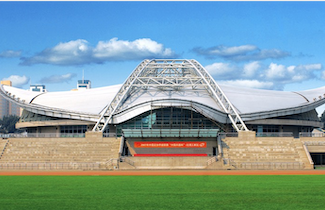
Cycling along Zhongguancunnan Street for another two kilometers, you will arrive at the Beijing Institute of Technology.
Formerly known as the Academy of Natural Sciences established in Yan'an in 1940, the Beijing Institute of Technology (BIT) is the first science and engineering university founded by the Communist Party of China. It has been the first batch of universities which have been listed into the national "211 Project", "985 Project" and the "Category A Universities in the First-Class University Program". The name of BIT was inscribed by Chairman Mao.

Cycling along Zhongguancunnandajie for another five kilometers, you will arrive at the Peking University.
Originated as the Imperial University of Peking established in 1989, the Peking University is China's first national comprehensive university. Renamed as it is in 1912, the Peking University is the earliest spreader of Marxism and democratic science in China. As the first activity base for the Communist Party of China, the Peking University has made irreplaceable contributions to national rejuvenation and liberation, national construction and development, and social civilization and progress, thus acting as an important pioneer in China's journey towards modernization.

Turning right from the crossroad near the east gate of Peking University to Chengfulu and cycling for around two kilometers, you will arrive at the Tsinghua University.
Originally under the name "Tsing Hua Imperial College", the Tsinghua University was established in 1911 and got its name for it sits on a land of woods and water. After the founding of People's Republic of China in 1949, the Tsinghua University has gradually developed into a comprehensive and research-oriented university, and has been listed into the national "211 Project", "985 Project", the "World-class Universities and First-class Disciplines" and other alliances.
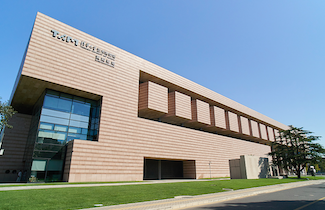
Turning left from Chengfulu to Heqinglu and cycling for 2.5 kilometers, you will arrive at the Tsinghua University Art Museum.
Situated on the east side of Tsinghua University, the Tsinghua University Art Museum was officially open to the public in 2016 as a national Grade Ⅰ museum. The Tsinghua University Art Museum houses more than 20,000 pieces of collections, covering six major categories, namely, painting and calligraphy, embroidery, porcelain, furniture, bronze ware and comprehensive artwork. Most of the collections are from Academy of Arts & Design since 1956, and donations from Tsinghua alumni or some social elites.

Cycling around the Tsinghua University for half a circle after entering Heqinglu, and turning left to Zhongguancunbeidajie, you will arrive at the Yuanmingyuan Park.
Built in the 46th year during Emperor Kangxi's reign (1707), the Yuanmingyuan is composed of three gardens: Yuanmingyuan, Changchunyuan and Qichunyuan and is renowned as the "model of all garden construction arts" and the "Garden of Gardens". The Yuanmingyuan Park has also created the "Yuanmingyuan Royal Merchant Street", and nearly 30 special stores are open for business on the street offering tourists local food of Beijing, snacks and local specialties, coffee and fruit beverage, cultural creative merchandises, light and shadow experience space and other experience. This is a must-visit place if you come here.
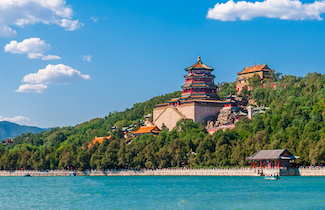
Turning right to Qinghuaxilu, and cycling for one kilometer to Xiheyuanlu and all the way to Tongqingjie, you will arrive at the Summer Palace.
Undoubtedly as the treasure for Chinese classical gardens, Summer Palace was built in the 41st year during Emperor Kangxi's reign (1702). The Summer Palace is constituted by four parts, namely, imperial palaces, the front area of Longevity Hill, the back area of Longevity Hill, and Kunming Lake Area. It not only boasts a sophisticated overall design but also houses exquisitely designed buildings and landscape, demonstrating China's highest level of gardening art.

After entering Kunminghudonglu, you need to cycle for around 3.5 kilometers to Landianchengbeilu, and then to Wanshousilu after a ride along Jingmi Diversion Canal and finally to the finish point of this route after another two-kilometer ride.
Located at the northeast corner of Wukesong Bridge along Chang'anjie, the Wukesong Arena has officially become a landmark stadium for cultural and sports events after the 2008 Summer Olympics. In April, 2020, the Wukesong Arena officially kickstarted its renovation project, with the aim to transform itself into the venue for the ice hockey competition of the 2022 Winter Olympics. It is an important site to meet the needs of the community residents in the west of Beijing for commerce, culture, sports and leisure.
- Cycling Route9 Introduction
- Cycling Route9 map
- Cycling Route9 route
- Cycling Route9 along
Adjacent to the Yongding River, the "mother river" of Beijing, Fengtai District echoes with a large number of historical cultural symbols such as Lugouxiaoyue (means there is a beautiful moon above the Lugou Bridge) and Wanping Ancient City.
A cycling route connects many famous scenic spots such as Nangong Scenic Area, Beijing Qinglong Lake Park, Lvyexianzong Natural Park, and Beijing Qianling Mountain Park, attracting numerous cycling enthusiasts and tourists.
Monday to Friday
10:00-17:30
(Last entry at 16:00)
Weekends and statutory holidays
09:00-17:30
(Last entry at 16:00)
10:00-21:00
08:00-11:00
14:00-17:30
9:00-22:00
(The site will be cleared at 21:30)
9:00-18:00
(Last entry at 17:00)
9:00-17:00
9:00-18:00
Peak season: (March to October) 8:00-17:30;
Low season: (November to next February) 8:00-17:00

Planned route
Nangong World Geothermal Expo Park (Wuzhou Botanical Amusement Park) - Nangong Ethnic Hot Spring Health Garden - Dianqi Jingang Agricultural Park - Nangong Hot Spring Water World - Nangong Camping and Sports Park - Beijing Qinglong Lake Park - Lvyexianzong Natural Park - Beijing Qianling Mountain Park

Road condition
gentle bicycle lanes and some sections of uphill road

Target groups
all ages, with their own bikes or shared bikes

Length
around 24 kilometers

Suggested time to finish
around four hours
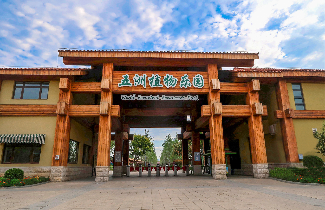
#
The Nangong World Geothermal Expo Park (Wuzhou Botanical Amusement Park) is constituted by the Parrot Garden, Bird Paradise and Greenhouse Amusement Park. Specifically, the Parrot Garden is a parrot-themed park integrating bird caring, bird watching, bird feeding, bird protection and ecological environment protection. The Bird Paradise houses over ten thousand birds and also more than 60 varieties of aquatic animals. The Greenhouse Amusement Park comprises eight themed parks and Huaguo Mountain offers a number of amusements for children. In short, the Nangong World Geothermal Expo Park is a parents-child themed park that integrates natural ecological scenery appreciation, leisure and entertainment, science popularization and teaching through lively activities.

Departing from the Nangong World Geothermal Expo Park and walking to the southwest for around 150 meters, you will arrive at the Nangong Ethnic Hot Spring Health Garden.
The Nangong Ethnic Hot Spring Health Garden is constituted of three indoor floors, a four-season health preservation center, outdoor hot spring pools with ethnic characteristics, and a health preservation-themed hotel. The first indoor floor is the reception hall, where the pools and hot spring bath area can accommodate 1,600 people for hot spring bathing at the same time. The second floor is the catering area. The third one is the leisure and entertainment area which houses a series of facilities such as a lobby, a film hall, a chess and card room, a SPA, a beauty salon, a tea art area and a physical therapy area.
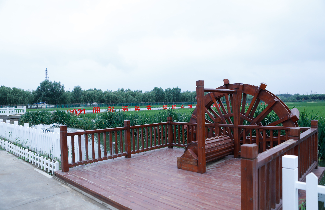
Moving northward along Nangongyinbing Road from the east gate of the Nangong World Geothermal Expo Park, turning right to Nangong Road and cycling for around 1.8 kilometers to Changqing Road where you will move forward for around 88 meters before turning right, you will arrive at the Dianqi Jingang Agricultural Park after another 540-meter-ride.
The Dianqi Jingang Agricultural Park covers a total land area of around 66.7 hectares (1,000 mu). Situated in the waters by the Tanzhe Temple in western Beijing, it is mainly used to grow rice as its major crop thanks to its favorable natural conditions, thus being renowned as the "land of fish and rice in North China". Spring and summer here offer tourists a splendid flower sea, and autumn enables tourists to appreciate a rice field painting. The park also launches farming experience projects that enable family farming activities and bring tourists a pleasant farming experience.
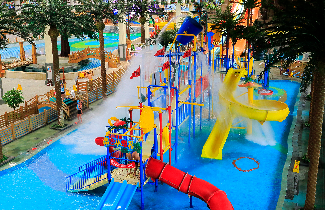
Departing from the Dianqi Jingang Agricultural Park and cycling along Changqing Road, Fugong Road and Kangquan Road for around 3.3 kilometers, you will arrive at the Nangong Hot Spring Water World.
The Nangong Hot Spring Water World is known as the "Hawaii in western Beijing". With a beautiful indoor environment, it offers tourists a series of water entertainment facilities such as a swimming pool in compliance with international standards, a raft slide, a large-scale water slide, a paddling pool for adults, a wave pool, a paddling pool for children, and a hot spring massage pool as well as other facilities like stone bathing facilities and shared sauna rooms, making it an ideal indoor hot spring and water paradise.
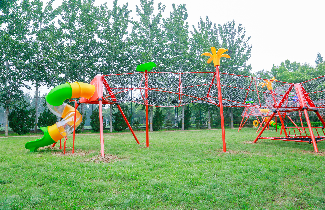
Departing from the Nangong Hot Spring Water World and cycling along Yiquan Road and Xinyuan Middle Street for around 1.2 kilometers, you will arrive at the Nangong Camping and Sports Park.
Situated in the Nangong Scenic Area and adjacent to the Nangong Exit of the Beijing-Hong Kong-Macao Expressway, the Nangong Camping and Sports Park (formerly known as the Nangong Sports Park) boasts convenient transportation and is a comprehensive and multi-functional themed park integrating sports fitness, parent-child activities, and outdoor camping. The sports activities offered here include soccer, basketball, tennis, cosplay of counter strike, team building and development training; Parent-child projects include physical development, karting car driving and jungle crossing; Outdoor camping involves tent pitching and self-service barbecue.

Cycling along Nangongbinhe Road, Quanhu East Road, Quanhu West Road and Yuehu Middle Street for around 5.5 kilometers, you will arrive at the Beijing Qinglong Lake Park.
With lush mountains and lucid water, the Beijing Qinglong Lake Park offers tourists fresh air and therefore is an internet-famous location for people to take a stroll and breath its fresh air. The water-running steps in the beach paddling area are a unique artificial landscape in the park, attracting many tourists to experience the pleasure of paddling in person. The park is equipped with many entertainment facilities and allows tourists to put up tents, have a barbecue with friends and fully enjoy their leisure and worry-free moment.
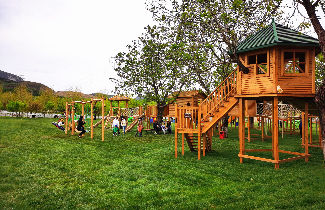
Cycling along Yuehu Middle Street, Shanhu Road, Minzuyuan Road, Linghu Road, Shayang Road, and Houpuying Road for around 9.1 kilometers, you will arrive at the Lvyexianzong Natural Park.
With an outdoor area of 120,000 sqm, the Lvyexianzong Natural Park is rated as one of the internet-famous sites in Beijing in 2020 and 2021 for two consecutive years. It offers a broad horizon, fresh air, and a splendid flower sea, making people feel relaxed and happy. The amusement theme in the park is rich and diverse and there are many amusements such as log cabins to the interest of children, excavators driving and horse riding, making it an ideal place for children to have enough fun. Besides, the park's log cabins and camping sites are suitable for outdoor camping.
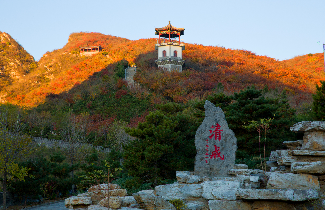
Cycling along Houpuying Road for around 2.6 kilometers after the tour in the Lvyexianzong Natural Park, you will arrive at the Beijing Qianling Mountain Park.
As a part of the Ma'anshan Mountains, the Beijing Qianling Mountain Park impresses tourists with its marvelous peaks, grotesque stones, luxuriant plants and abundant wild resources. The scenic area occupies a total land area of 2.2 sqm, and its main peak, Jile Peak, is 699 meters above sea level, over 100-meter higher than Xianglu Peak in Fragrant Hills Park, thus being regarded as the highest mountain in the southwest of Beijing. The scenic area boasts Beijing's longest sightseeing cableway and Beijing's largest grotto temple compound, making it an ideal place for people to keep fit and explore mysterious and magnificent natural scenery.
- Cycling Route10 Introduction
- Cycling Route10 map
- Cycling Route10 route
- Cycling Route10 along
A winter Olympic event that attracts worldwide attention has turned Shougang Park into a world-renowned dreamland and placed Shijingshan District under the spotlight of the international community.
Let us cycle in Shougang Park to feel the joy of the city and engrave the Winter Olympics in our memory. This park has witnessed the great development history of China's manufacturing industry that carries forward the cause and forges ahead into the future. Moreover, it records the most magnificent chapter of this "Dual Olympic City"!
All day
All day
Saturday to Sunday
10:00-12:00
13:00-17:30
Tuesday to Friday
10:00-18:00
Saturday to Sunday
10:30-21:30
Closed on Mondays
(except for statutory holidays)
Indoor (40-meter-long platform)
Saturday to Sunday
10:00-17:00
Outdoor: All day
All day
The opening hours are subject to actual conditions.
All day

Planned route
Shangri-La Shougang Park—New Shougang Bridge—Big Air Shougang—Liaocang Art Museum—No.3 Blast Furnace—Xiuchi Pool—High Line Park—Shangri-La Shougang Park

Road condition
gentle bicycle lanes

Target groups
all ages with their electric bikes or private bikes.

Length
around 16 kilometers

Suggested time to finish
around 4.5 hours

Departing from the Shangri-La Shougang Park and cycling along Qunminghu West Street, Wuyijuchang South Road, Qunminghu Street and Shijingshan Road for five kilometers, you will arrive at the New Shougang Bridge, where you can appreciate the mountain, river and lake scenery of Shougang Park from an ideal viewing point.
The New Shougang Bridge stands like a steel artwork impressing tourists with its strength and beauty. The two inverted U-shaped steel towers lean toward the east and west, respectively. On the bridge lies a viewing point, presenting a grand scenery in which the cooling tower, Qunming Lake and Big Air Shougang add radiance to each other and constitute a splendid city skyline against the Xishan Mountain. The bridge has become a famous site for shutterbugs to take photos.
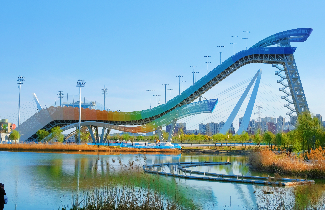
Turning back to the south gate of Shougang Park after a ride along Qunminghu North Road and Qunminghu West Street, and cycling for another 2.5 kilometers, you will arrive at the Big Air Shougang, a blessing land in western Beijing.
As the venue for freestyle skiing and snowboarding competitions during the 2022 Beijing Winter Olympics, the Big Air Shougang is the only snow event stadium in the downtown area of Beijing and also the world's first city big air venue that is permanently preserved and used. The design of this stadium is inspired by the "flying Apsaras" in China's Dunhuang murals. Since the word "flying Apsaras" and "Big Air" both imply the meaning of "jumping and flying", it is named the "Big Air Shougang", a name that perfectly combines the traditional Chinese elements and modern ice and snow sports, and echoes the manufacturing style of Shougang Park.
Currently, the departure area of the Big Air Shougang is open to the public. Tourists can make reservations via the Mini Program of "AI Shang Shougang Park" to feel the excellence of Olympic champions and experience the heartbeat of racing for gold medals.
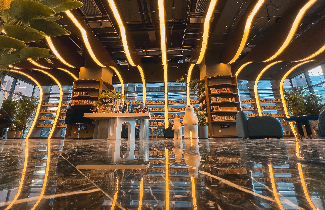
Cycling along Qunminghu West Street, Xiuchi West Street, Xiuchi South Road and Qunminghu Street for two kilometers, you will arrive at the Liaocang Art Museum.
Formerly known as the ferrous powder "silo" in the Shougang, the Liaocang Art Museum was renamed the "Liaocang" (homonym of silo in Mandarin) after the renovation. On the one hand, the name carries forward and upholds its original industrial and cultural spirit. On the other hand, it manifests its functional positioning of immersive visual experience and its hope and vision for the future. With a total land area of 8000 sqm, the venue comprises four floors and is mainly used to hold immersive light and shadow art exhibitions. Meanwhile, it offers tourists facilities that bring a comprehensive consumption experience such as a bookstore, a restaurant, a bar and a fair. You can come here with your friends and capture stunning moments of light and shadow.

Cycling along Qunminghu Street for one kilometer, you will arrive at the No.3 Blast Furnace to feel the diverse charm of iron and steel culture.
As the first modern large-scale blast furnace with a capacity of over 2,500 cubic meters, the No.3 Blast Furnace used to be a blast furnace that greatly contributed to Beijing's or even China's iron and steel industry. This site has witnessed the holding of multiple cultural events, including the China Science Fiction Convention, Beijing's New Year Countdown Celebration, and the opening ceremony of the Beijing Fashion Week. On the first floor of the No.3 Blast Furnace lie the LReading Art Bookstore, Winter Olympics Franchise Store and Beijing Gift, where you can purchase cultural creative products with the characteristics of Shougang. You can also collect stamps at the cashier at the north gate of the LReading Art Bookstore to share this moment on social media.

Departing from the No.3 Blast Furnace and cycling for no more than one kilometer, you will arrive at the Xiuchi Pool.
Formerly known as the Xiuhu Lake, the Xiuchi Pool was established in 1940. With a total water area of 34,000 sqm, it was used to store water that is circulated for ironmaking, and was also the earliest water landscape of Shougang. During the renovation of the Xiuchi Pool, the original water landscape was preserved, based on which, the underground space of the industrial cooling pool was effectively utilized and was renovated into an underground garage and underwater exhibition hall. The Xiuchi Pool and the No.3 Blast Furnace are connected by an underwater corridor.
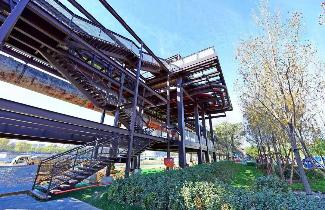
Cycling along Xiuchi West Street, Qunminghu West Street and Qunminghu North Road for two kilometers, you will arrive at the High Line Park.
The High Line Park is an urban public space landscape with a linear elevated landscape walkway as the main body. It was renovated based on the original industrial pipe rack with a height of 14 meters and a total length of 8.2 kilometers. It is a linear public space in the air that integrates non-motorized traffic, sightseeing and leisure, fitness and entertainment, and is over three times longer than the famous High Line Park of New York City. When you stroll on the second floor of the north section of Qunming Lake walkway, you can appreciate the scenery of Qunming Lake on the south side and find an ideal place to take photos of the north side of the Big Air Shougang.

Cycling along Qunminghu West Street for one kilometer, you will arrive at the Shangri-La Shougang Park, an artistic five-star hotel for you to take a rest.
The Shangri-La Shougang Park was mainly designed by Piero Lissoni, an Italian architect from Lissoni Casal Ribeiro S.p.A. Building on the foundation of the original Shougang Power Plant, the designers have preserved its distinctive industrial style and brilliantly incorporated the aesthetic elements of modern architecture. The hotel lobby at the first floor is covered by various evergreen plants, resembling an indoor botanic garden. The red steel spiral staircase and the "flying bird" art installation add radiance to the photos you take. The Shang Market and the Power Station Lounge and Bar provide you with diversified dining experience and also the exclusive afternoon tea with the Big Air Shougang as the theme. At the concierge of the first floor, you can collect the brand stamps of Shijingshan District that is engraved with characters of "Yan Du Di Yi Xian Shan" (meaning the top fairyland-like mountain in Beijing).
- Cycling Route11 Introduction
- Cycling Route11 map
- Cycling Route11 route
- Cycling Route11 along
As an ecological conservation area, Mentougou District is run through by the Yongding River. The Beijing section of the Yongding River stretches for around 170 kilometers, among which 102-kilometer-length is in Mentougou District, thus breeding Yongding River culture (including the Great Wall culture, geological culture, colored glaze culture and imperial exam culture) with a unique charm.
The cycling route, around 38-kilometer long, covers a series of tourist attractions with their own unique characteristics including the Yongding Tower, Liuliqu Village, Dongshiguyan Village, Dongmagezhuang Village, Ximagezhuang Village, Nangang Village, and Jiuyuan Village.
With abundant cultural tourism resources like ancient villages and roads and other scenic spots, as well as local food, this route is designed to fully showcase the unique intangible cultural heritage and historical culture of Mentougou District.
09:00-17:00
All day
All day
08:00--18:00
07:00--17:00
08:00--18:00
08:00--17:30
09:00-19:00
08:00-17:00

Planned route
Yongding Tower→ Liuliqu Village→ Dongmashanjia Boutique Homestay→ Xima Leisure Farm→ Flower Sea Wooden Plank Road→ Mazhiyuan Former Residence→ Jingxi Ancient Road Sculpture Stele→ Ms. Jiu's Leisure Park→ Jiuyuan Pickle Factory

Road condition
a cycle track with relatively large inclination, bringing cyclists a great fun

Target groups
cycling enthusiasts

Length
around 38 kilometers

Suggested time to finish
eight hours (the time for visit included)
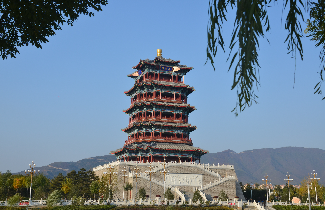
#
Situated on the bank of the Yongding River, the Yongding Tower is a landmark building of Mentougou District. The square in front of the Yongding Tower, with a total land area of 28,000 sqm., is a gathering place for cycling enthusiasts. Charming and solemn, the Yongding Tower constitutes the Yongding River cultural landscape system together with the Yongding River Viewing Deck, the Yongding River Cultural Wall and the Yongding River Mother Sculpture, and is regarded as an important site for leisure and entertainment as well as for the appreciation of the historical culture of Yongding River.

Cycling along Shidan Road for 3.7 kilometers, you will arrive at Liuliqu Village, which is renowned as the "hometown of colored glaze" and is also an internet-famous place worth your visit.
Surrounded by hills and streams, Liuliqu Village boasts picturesque scenery. It is also endowed with abundant natural resources and rich historical and cultural deposits, thus successively being rated as "China's famous historical and cultural village" and "China's colored glaze culture village". The colored glaze firing technique of this village is even listed as an item of national intangible cultural heritage. You can also appreciate the village's many cultural relics and ancient road culture.
Listed as an item of national intangible cultural heritage, the colored glaze firing technique of Mentougou District can be traced back to the early Yuan Dynasty and is more than 700 years old. The colored glaze has become a traditional Chinese product mainly used for building materials.
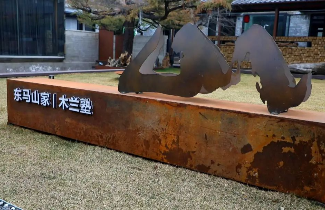
Cycling all the way west along Shidan Road for 16.9 kilometers, you will arrive at Dongmagezhuang Village after passing through Dongshiguyan Village in the east of Wangping Town.
Dongmagezhuang Village preserves the only three-arch bridge on the Jingxi Ancient Road, allowing you to enjoy the scenery along the road. The Dongmashanjia Boutique Homestay in the village is an internet-famous location worth your visit. It features a series of decoration styles in different functional areas such as rustic and European styles. A restaurant and café lie in the courtyard, where cyclists can stop by to taste the local specialties and refuel their energy.
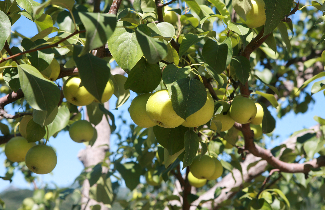
A 340-meter ride from Dongmagezhuang Village leads you to Ximagezhuang Village.
When passing by Ximagezhuang Village, you can have a tour around the Xima Leisure Farm, where you can take away a seasonal gift with Jingxi's characteristics for your friends and family members while enjoying fruit picking. Besides, a zoo area is created in the orchard of the farm, allowing you to interact with small animals and feel the unique fun of the countryside.
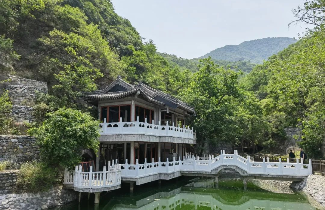
Nangang Village, 1.6 kilometers away from Ximagezhuang Village, is situated at the foot of the Jiulong Mountain.
Nangang Village boasts a sound ecological environment with lush mountains and lucid water. It is endowed with abundant natural resources with its forest coverage rate reaching as high as 90 percent. The village is built on the mountain slope and enjoys an extremely sound environment. The Cloud Flower Sea Wooden Plank Road in the village offers you a magnificent scenery, with the east boardwalk stretching for 3,000 meters long and the west, 500 meters. It is the first choice for the hiking and sightseeing of tourists. The village also houses alpine orchard where fruits such as cherries and Jingbai pears are planted.
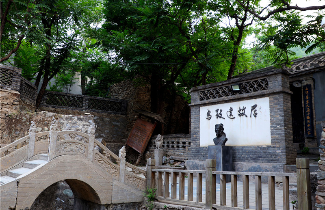
A 2.6-kilometer ride along Dongjiu Road from Nangang Village leads you to Jiuyuan Village, the most charming village in Beijing. It is also the village where the Mazhiyuan Former Residence is situated.
A stream flows under the old trees in front of the Mazhiyuan Former Residence. When you arrive here, you can slow down to feel the lingering charm of the verses of Mazhiyuan, a poet and playwright in the Yuan Dynasty.
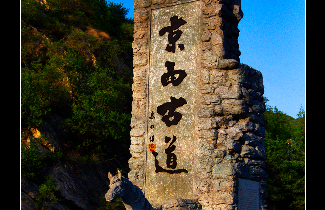
Departing from the Mazhiyuan Former Residence and cycling along the villages for 160 meters, you will arrive at the Jingxi Ancient Road Sculpture Stele.
If you want, you can stop by and walk along the mountain trail to the Jingxi Ancient Road Scenic Area, which is around 800 meters away from the Jingxi Ancient Road Sculpture Stele. The scenic area offers you a series of tourist attractions such as the Jingxi Ancient Road Museum, Niujiaoling Pass, and Guandi Temple, where you can stop by to take a selfie, feel the charm of the ancient road, gain a deep understanding of the folk culture and enjoy the natural scenery.

Departing from the Jingxi Ancient Road Sculpture Stele and cycling all the way north for 1.1 kilometers, you will encounter two cartoon sculptures with vivid figures. At this moment, you arrive at the Ms. Jiu Leisure Park.
Here you can trace the origin of the stream, have a barbecue with your friends and put up tents. Surrounded by hills and creeks, this area offers you an extremely broad horizon. Sitting in the park, you can enjoy a barbecue, feel the breeze and listen to the murmuring of creeks with children playing around. You can also play with water on the shoal by the river.
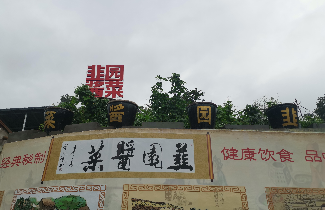
Departing from the Ms. Jiu Leisure Park and cycling for 110 meters, you will arrive at Jiuyuan Village where the pickle is a must-try local specialty.
The pickling technique of Jiuyuan Village, listed as an item of the intangible cultural heritage of Mentougou District, originated in the Ming Dynasty when Emperor Wanli was on the throne (1572-1620). The local pickles were gradually derived after the sauce was successfully made in the village. With natural green vegetables and local spring water as the major ingredient, and thanks to a series of natural resources such as the suitable temperature, the pickles of Jiuyuan Village are bright in color, tender in texture, and rich in sauce flavor.
- Cycling Route12 Introduction
- Cycling Route12 map
- Cycling Route12 route
- Cycling Route12 along
A trip to Fangshan takes you back to billions of years ago. More than one billion years of natural vicissitude and millions of years of geological changes have created a magical landscape here; while 700,000 years of human activities and 5,000 years of civilization have nurtured a unique history and culture of this place. That is why Fangshan can be the best place for you to explore the evo Roadtion of the earth and trace the history of human development.
9:00-16:30 (April 1-October 10; last entry at 16:00; and closed at 16:30)
9:00-16:00 (October 11-March 31, last entry at 15:30, and closed at 16:00)
9:00-15:30 (closed at 17:00)
9:00-15:30 (closed at 17:00)
Mondays to Sundays: full day
Mondays to Sundays: 8:30-17:00
Closed on Mondays
Tuesday to Sunday, 9:00-16:00
(Last entry at 15:30)
9:00-17:00 (Last entry at16:30)

Planned route
Peking Man Site at Zhoukoudian - Shangfang Mountain - Yunshui Cave - Fuga Camp - Longmen Ecological Park - Museum of Fangshan UNESCO Global Geopark of China - Yunju Temple

Road condition
As a routealmost meeting all needs of tourists, it contains flat areas, slopes, and upheavals. You can't miss this route as a cyclist because it is ideal for both training and sightseeing as the entire route winds through Shangfang Mountain Scenic Area.

Target groups
amateurs and more advanced cyclists

Length
about 52 kilometers

Suggested time to finish
about eight hours

#
As the birthplace of Peking Man (also known as Homo erectus pekinensis in paleoanthropology), Peking Man Site at Zhoukoudian is located in Zhoukoudian Town, Fangshan District, 43 kilometers from downtown Beijing. It is a paleoanthropological cultural site well-known in China and around the world. The excavation of the skulls of Peking Man and massive evidence of fire use has provided vivid and powerful empirical evidence for the study of human evolution.
It was included in the World Heritage List (cultural category) by UNESCO in 1987, and was selected as one of the Top Tourist Attractions for Beijing in 1992. Here, you can feel the mystery of ancient times and learn about the civilization of fire, take a glimpse into the long history and the vicissitudes, and understand the charm of the ancestral culture of China.
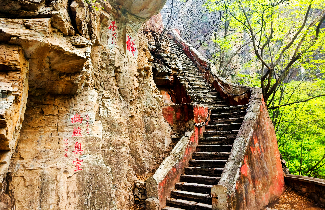
Ride 21 kilometers along Fangyi Road and Longxia Road to reach Shangfang Mountain Scenic Area.
Located in Hancunhe Town, Fangshan District, Beijing, 58 kilometers from downtown Beijing, Shangfang Mountain National Forest Park is one of the 20 National Key Demonstration Forest Parks in China. Since the Eastern Wei dynasty (AD 534-550), there have been monks building temples and roads and planting trees on Shangfang Mountain. After subsequent construction and renovation for generations, Shangfang Mountain reached a magnificent scale in the Ming Dynasty (AD 1368-1644). Generations of historic figures, writers and calligraphers not only created poems and paintings but also built temples and pavilions here, making this scenic area become a religious resort with charming landscapes that integrate bridges, pavilions, temples, caves, rocks, peaks and forests. Hence the saying "There are Suzhou and Hangzhou in the south, and we have Shangfang in the north."
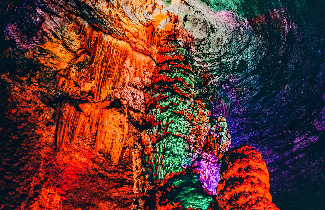
#
Located in Shangfang Mountain National Forest Park, Yunshui Cave is found 530 meters above sea level at its entrance. It's one of the earliest-developed caves in Beijing. Currently, 613 meters of the cave path have been explored, including seven halls and 108 naturally formed Karst landscapes. Among them, the most famous one is the "Tian Zhu" (which literally means "column reaching the sky"), the highest stalagmite in China. Based in the 2nd hall, "Tian Zhu" stands 38 meters high and eight meters in diameter. On both sides of the stalagmite, there are rows of stalactites of different sizes, which can create music like musical instruments upon beating. In Yunshui Cave, you can see the magic of nature such as the grotesque rocks and musical stalagmites.
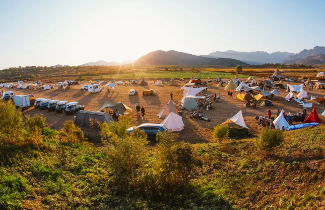
To reach the camp, ride along Yuesheng Road and Longxia Road for 10 kilometers.
Located in Tiankai Reservoir, Tiankai Village, Hancunhe Town, Fangshan District, Fuga is a lifestyle brand focusing on natural aesthetics, and currently, it operates "Fuga Camp" and "Fuga Farm". Fuga Camp is a camping area closest to the downtown with the most convenient transportation conditions.
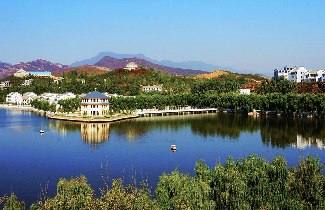
Ride along Tiankai Road and Fangyi Road for 4.3 kilometers to reach the Longmen Ecological Park.
Located in Longmen Village, Hancunhe Town, Fangshan District, Beijing, Longmen Ecological Park covers an area of about 107 hectares, including the picturesque reservoir of about 27 hectares. The park has three functional parts for tourism, retirement and health preservation respectively.
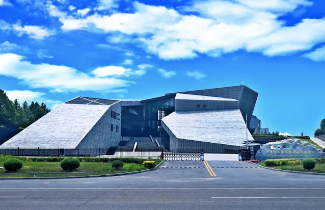
Ride along Fangyi Road for 6.8 kilometers to reach the Museum of Fangshan UNESCO Global Geopark of China.
Located in Changgou Town, Fangshan District, the museum covers an area of 61,100 square meters, with a total construction area of 10,000 square meters. The design concept of the museum is "Ground-breaking Stone", and the overall construction is unique and typical as it follows the natural terrain and indicates the origin of mankind. The museum is built for the purposes of science education, leisure tourism, geological research, exhibitions and information sharing.
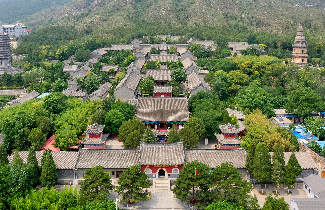
Ride along the Yunjusi Road for 10.2 kilometers to reach the Yunju Temple.
Located in Dashiwo Town, Fangshan District, Beijing, 65 kilometers from downtown, Yunju Temple is a famous monastery in Beijing. The temple was built during the Daye period (AD 605-618) of the Sui Dynasty and houses a large number of sutras recorded on paper, wood and stones, which are collectively known as the "Three Wonders of Yunju Temple". Over 16 generations of inheritance, spanning over six dynasties for more than a thousand years, the monks in Yunju Temple carved sutras on 14278 pieces of objects in 3572 volumes, sorted in 1,122 collections, all found hidden in nine caves and the cellar of Yunju Temple. The discovery of these sutras is a remarkable event in world sutra-engraving history, and they have been regarded as the "Dunhuang of Beijing", or the "Great Wall of Stone Scriptures".
- Cycling Route13 Introduction
- Cycling Route13 map
- Cycling Route13 route
- Cycling Route13 along
The Grand Canal, a great river that has been flowing for thousands of years, is the lively and running spiritual home of the Chinese people as a unique living cultural heritage item. It has nurtured shiny and renowned cities and towns and gained a profound cultural background.
Today, riding on the banks of the ancient Grand Canal, we can see many high-rise buildings on both sides. And the water reflection of ancient towers visualizes that the long history and modern urban settings have subtly integrated into a beautiful and magnificent landscape...
Mondays to Sundays:
8:00-22:00
Mondays to Sundays:
8:00-22:00
Mondays to Sundays:
8:00-22:00
All year round
All year round
Mondays to Sundays:
9:00-17:00
(Reservation and admission stop at 16:30)
All year round
All year round

Planned route
Beijing (Tongzhou) Grand Canal Cultural Tourism Scenic Area - Wuxing Road (Gantang Bridge) - Grand Canal Cultural Tourism Scenic Area (West Gate 5) - Yuedao Wenying - Yuedao Viewing Platform - Luyang Bridge - Yuntong Bridge - Dongguan Bridge - Grand Canal Cultural Tourism Scenic Area (Three Temples and One Pagoda) - Seven-Arch Bridge - Daguang Building - Qianhexielu Bridge - Grand Canal Cultural Tourism Scenic Area (Canal Culture Square) - Yudaihe Bridge -Beijing (Tongzhou) Grand Canal Cultural Tourism Scenic Area

Road condition
flat bicycle lanes, with some secluded alleys

Target groups
people of all ages with their own bikes or shared bikes

Length
35-kilometer-long small loop ride

Suggested time to finish
three to four hours

Caoyun Terminal, the starting point of the cycling route, has a long history.
People nowadays may be unfamiliar with the word "caoyun" (which means "water transport" in archaic Chinese). During the past imperial dynasties of China, especially the Ming and Qing dynasties, boats and ships engaging in "caoyun" on the Beijing-Hangzhou Grand Canal constituted a lifeline to maintain the normal operation of the country. During the Qing Dynasty, hundreds of millions jin (nearly 600 grams) of grain were gathered each year at the Shiba Terminal and the Tuba Terminal in Tongzhou, and then transferred to the capital's warehouses along the Tonghui River and via the moat. Nowadays, the green glazed tile-roofed weighing hall and the small green tile-roofed windlass well house of the Caoyun Terminal seem to be telling the grand stories of water transportation centuries ago.

Ride southwards from the Caoyun Terminal, cross Gantang Bridge to the west bank of the Grand Canal, go northwards all the way, and you will arrive at the Yuedao Wenying.
The scenic spot "Yuedao Wenying" is located in the south area of the Grand Canal Cultural Tourism Scenic Area. Yuedao is featured by a convex and concave terrain formed in the process of river training in the North Canal. Surrounded by water on all sides, it resembles a crescent moon, hence the name Yuedao (which literally means "moon island" in Chinese). Yuedao Wenying has a planned area of 256 mu (about 17.06 hectares). Various trees, shrubs, flowers and grasses are planted all over the island, providing an unprecedented natural environment for nesting birds. Birds come here in large droves, with bird and insect chirping to be heard everywhere on the island. In addition to nature's singing, you can also see eye-catching green vegetation, and nightingales that soothe the heart. Moreover, Yuedao Wenying is also a sacred place for lotus viewing. The 100-mu-large (about 6.67 hectares) lotus pond is divided into two by a long bridge. Looking from afar, the emerald green lotus leaves are dotted with pink lotus, a great feast for your eyes.

#
On the highest point of Yuedao, you'll find the viewing platform, which is also an Internet-famous destination in Tongzhou. The 18-meter-high red building stands steadily on the shore of Yuedao, from which visitors can view the Grand Canal on its first floor, Tongzhou on its second floor, and Beijing Municipal Administrative Center on its third floor.
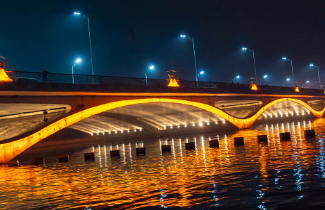
Riding northwards from Yuedao Viewing Platform, you will pass many featured bridges. After going across Luyang Bridge, you will arrive at Yuntong Bridge.
Yuntong Bridge is the "boundary marker" between Yunhe West Street and Yunhe East Street, as well as one of the first bridges equipped with lighting facilities on the North Canal. After nightfall, its ever-changing colors render the whole bridge's night scene in a more dynamic, energetic, pleasing and relaxing way for visitors.
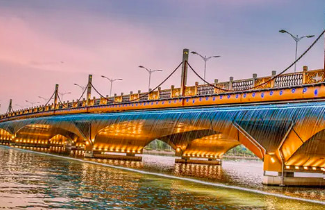
Go northwards from Yuntong Bridge, and you will arrive at Dongguan Bridge.
Dongguan Bridge is located on the extension of Chang'an Street. Spanning the North Canal (the starting point of the Beijing-Hangzhou Grand Canal), it serves as the only river-crossing bridge on the extension of Chang'an Street. The bridge has a good-looking structure, and such decorations as bronze-like surface and the reliefs on the railing give the bridge an air of history.

Cycle for about two kilometers from Dongguan Bridge, and you will come to the famous "Three Temples and One Pagoda" complex in Tongzhou District.
The three temples - Confucian Temple, Youshengjiao Temple and Ziqing Palace represent Confucianism, Buddhism and Taoism, respectively. The one pagoda refers to Randeng Pagoda, a Buddhist stupa. According to legend, during the Qing Dynasty, merchants who came to Beijing via the Grand Canal for thousands of miles from southern China were thrilled at the sight of the Randeng Pagoda merely from afar. It almost became a symbol of Beijing at that time. To this day, Tongzhou's Randeng Pagoda is still praised for its "cloud-capped ancient pagoda" as one of the Eight Scenic Areas in Tongzhou.
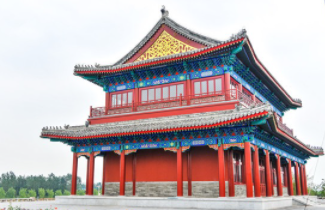
The famous Daguang Building can be seen from the "Three Temples and One Pagoda" complex, and the distance between the two is only about 1.5 kilometers.
Daguang Building, also known as Balou, was built in the Ming Dynasty during the Jiajing Period (AD 1522-1566); when it was rebuilt during the Tongzhi Period (AD 1862-1875) in the Qing Dynasty, three platforms were added on both the north and south of the building. The officials of the Ming and Qing dynasties were here to inspect the grains transported through the Grand Canal, so it was also called Yanliang (Grain Inspection) Building. Devastated more than a century ago, the building was reproduced on the west bank of the Grand Canal near its site at the beginning of the 21st century, bearing its original name.

Ride southwards from Daguang Building, and you will be greeted by a peculiarly shaped bridge, which is Qianhexielu Bridge.
The bridge is more than 360 meters long, with its steel beam structure weighing more than 8,000 tons. It has a three-layer landscape walkway, which takes a wave shape and resembles a cluster of dew-dripping lotus flowers when looked at from afar. When visitors stroll on the walkway, it seems that they were portraying the lotus leaf edge with their own feet.
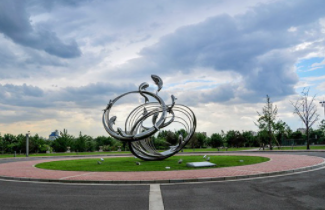
Crossing the Qianhexielu Bridge, the Canal Culture Square is up there.
The square is built on the east side of the Grand Canal, covering an area of 800 mu (about 53.33 hectares), including 600 mu (40 hectares) of green vegetation. In front of the square stands a colorful archway facing south, decorated with a plaque written by Ouyang Zhongshi, which reads "Canal Culture Square" in Chinese. After passing through the archway, you can see a granite stone sculpture of about five to six hundred meters in the middle of the main road, which by the name of "Millennium Canal" records the long history of the Canal.
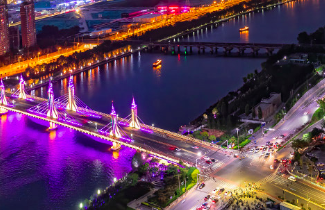
Yudaihe BrAbout 3.5 kilometers south away from the Canal Culture Square is the Yudaihe Bridge.idge
The bridge is 324 meters long, with eight-meter-wide motorized lanes, three-meter-wide non-motorized lanes and 2.5-meter-wide pedestrian walkways on both sides. Yudaihe Bridge is an important component along the North Canal landscape belt. The bridge has its distinctive architectural shape more apparent at night with color-changing lights offering an astonishing diversity of appearance to the bridge.
- Cycling Route14 Introduction
- Cycling Route14 map
- Cycling Route14 route
- Cycling Route14 along
The Chaobai River, known as "Beijing's Rhine River", is the mother river of Shunyi District. It runs through the north and south of Shunyi, nourishing the land on both banks, as well as the inhabitants of Shunyi. This cycling route starts near the bend of Chaobai River.
Now, say goodbye to hustle, bustle, and fatigue, and embrace wetlands, waterfowl and flowers. You can gaze at the mesmerizing scenery of the "Grand Canal Cultural Belt", as if an ecological scroll with gorgeous landscapes unfolded. Along the route, elements related to Olympic culture, intangible cultural heritage, red culture, and ecological forestry are closely connected together. Let's follow the footsteps of the martyrs to reactivate that classic red memory during this trip.
09:00-17:15
09:00-17:00
08:00-16:30
09:00-17:00
Tuesdays to Sundays:
09:00-16:30

Planned route
Shunyi Olympic Rowing-Canoeing Park - Beijing International Flower Port - Hanshiqiao Wetland - Oufeibao International Chateau - Beijing Jiaozhuanghu Memorial Museum of Tunnel Warfare Site

Road condition
flat cycle lane.

Target groups
people of all ages with their own bikes or shared bikes

Length
about 37 kilometers

Suggested time to finish
five to six hours
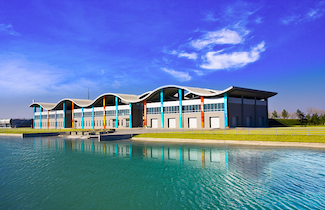
#
Located on the bank of the Chaobai River in Shunyi District, Beijing, Shunyi Olympic Rowing-Canoeing Park hosted the events of rowing, canoe slalom, canoe sprint, and marathon swimming of the Beijing 2008 Olympic Games, where 32 Olympic gold medals were conferred. After the Olympic Games, it has become a travel, leisure and vacation base of international quality with the park as the core and the Chaobai River as the decoration.

Cycle 9.7 kilometers eastwards from Shunyi Olympic Rowing-Canoeing Park, and you will arrive at Beijing International Flower Port where different kinds of flowers are in full bloom.
Beijing International Flower Port, with a favorable location and convenient transportation conditions, is one of the important venues for the 7th China Flower Expo hosted by Beijing in 2009. Flower festivals such as Beijing Tulip Cultural Festival and Chrysanthemum Cultural Festival are held here every year. The port has facilities including the "Butterflies in Love with Flowers Exhibition Hall", a tent hotel, and a camper town, supplemented by flowers and delicacies, all making it a place to linger.
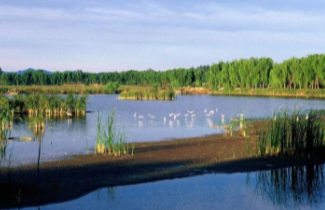
Go southward along Muyanlu for about eight kilometers, and you will reach Hanshiqiao Wetland.
Hanshiqiao Wetland Nature Reserve, located in the plain area in the northeast of Beijing, is a super-large reed marsh wetland, known as the "Oxygen Bar in Eastern Beijing", "Great Reed Marsh in Beijing Suburb" and "Baiyang Lake the Second". Here you can feel the joy of being close to nature.
In recent years, Shunyi District has launched a series of measures for wetland restoration and protection, which have improved the ecological environment of the wetland and the habitat of wild animals year by year. The number of birds and that of their species, other animals and plants has also been increasing for years. Currently, there are 226 species of birds, 62 percent (140 species) of which are the protected ones.

Depart from Hanshiqiao Wetland, ride northwards along Longyin Road for 10 kilometers, and three more kilometers after crossing the Jinji River, Oufeibao International Chateau is up there.
With refreshing air and beautiful scenery, Oufeibao International Chateau is located in Liuzhuanghu, the most beautiful village in Beijing, consisting of two parts, namely the winemaking area and club area. It is home to 80 mu (about 5.33 hectares) of vineyards, 20 mu (about 1.33 hectares) of orchards, and over 4,000 square meters of lawns. Here, you can experience the French-style winemaking process, visit the underground wine cellar, and taste its homemade wines. A number of well-designed boutique rooms in European style can meet the different needs of customers.

Ride along Longyinlu to the north for about five kilometers, and you will arrive at Jiaozhuanghu Memorial Museum of Tunnel Warfare Site.
Located in Longwantun Town, Shunyi District, Jiaozhuanghu Memorial Museum of Tunnel Warfare Site covers an area of 72.9 mu (about 4.86 hectares). It is a national demonstration education base for patriotism, a national red tourist attraction, a key historical and cultural site under national-level protection, and a national Anti-Japanese War memorial site. Due to its unique historical value, it has become a signature symbol of Shunyi red culture.
- Cycling Route15 Introduction
- Cycling Route15 map
- Cycling Route15 route
- Cycling Route15 along
Changping is engrossing in all seasons: wild peach blossoms bloom all over the hills in early spring; the fragrance of chestnut flowers fills the air in midsummer; red leaves are paired with white clouds in distant mountains in late autumn; and smoke is curling from artistic homestays in snow-covered mountains in winter. Cycle along the mountain roads in Changping, and you can enjoy the natural landscape, visit artistic villages, and gain cultural experiences.
All day
All day
08:00-17:00
All day
08:00-16:00
All day
08:00-17:00
All day

Planned route
Xiayuan Village Cultural Square - Taoyukou Reservoir's Observation Deck - Lianshanshi Waterfront Trail - Dayang Mountain National Forest Park - Shangzhuang Village - Humen Village - Yinshan Pagoda Forest Scenic Area - Wangbailu - Yanshou Temple "I Love Changping" Cyclists' Wooden House - Beizhuang Yanfangyuan Cycling Station - Cibeiyu Observation Deck - Baihe Reservoir - Baihe Village "I Love Changping" Cyclists' Wooden House - Xiayuan Cycling Base Camp

Road condition
Mountain roads constitute most of the route, alongside some secluded countryside roads.

Target groups
mainly for adults, with road bikes or mountain bikes. for parent-child groups as well, with their own bikes or mountain bikes.

Length
about 72.8 kilometers, with a climbing height of 996 meters in total

Suggested time to finish
Leisure mode: about one to two days Pro mode: about two to four hours

#
Xiayuan Artist Village, located in Xingshou Town, Changping District, is a place where sculptors, painters, musicians, dancers, designers and other artists gather and live in harmony with the villagers here, empowering the village with art. The vibrant culture cluster encompasses Kanpu Homestay, an artistic restaurant, and a cafe. Various art exhibitions have been held here. You can enjoy sculptures, rural murals and artist studios, as well as participate in activities of Xiayuan Cycling Base Camp.
Taoyukou Reservoir, one kilometer away from the start point (Xiayuan Artist Village), is adjacent to Yan Mountains on the north, and surrounded by mountains, rivers, and green trees. Cycling around here is refreshing.
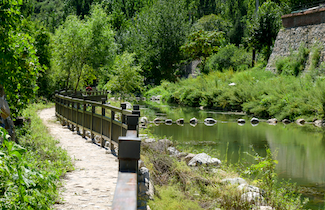
Ride along Taoyukoushuiku Road, and you will come to Taoxia Road, a famous mountain cycling greenway. There are two observation decks, where you can overlook Daqin Railway and Taoyukou Reservoir.
Ride along Taoxia Road for about six kilometers to reach the waterfront trail at the foot of the mountain nearby. Walk on the winding trail, and you can immersive yourself in the beautiful landscape. Lianshanshi Village Promenade is the first supply station for cyclists to take rests.
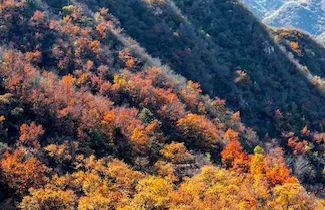
Keep riding along Taoxia Road for about six kilometers, and you will arrive at the natural oxygen bar - Dayang Mountain National Forest Park.
Located in Yanshou Town, Changping District, Dayang Mountain National Forest Park is part of Yan Mountains, with various landforms, steep mountains, lush forests evergreen all the year, and abundant water features.

Baihe Village's "I Love Changping" Cyclists' Wooden House is over there after a 5.5-kilometer ride along Taoxia Road. You can take a small break and then continue cycling on a rather flat downhill road of about 27 kilometers via Shangzhuang Village, Xiazhuang Village, and Shang'ansilu, before arriving at Humen Village and Yinshan Pagoda Scenic Area.
Situated closely to Yinshan Pagoda Scenic Area, a National Park of China, Humen Village is surrounded by mountains and lush vegetation, with diversified agricultural products and picturesque scenery everywhere. In addition to climbing mountains and exploring ancient sites, you can take a stroll along the "Dynamic Stream" waterfront trail, live in the Caomu Yuanju Homestay, and watch the verdant leaves of the ginkgo trees, to feel the rustic charm.
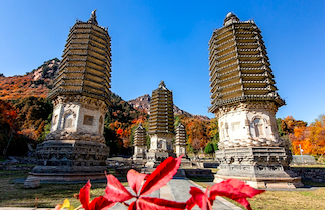
#
Yinshan Pagoda Scenic Area, as a National Park of China, is listed as a key historical and cultural site under national-level protection and a national AAAA-level tourist attraction. The towering mountain got its name Yinshan (Silver Mountain) from the fact that it is layered with ice and snow, glistening like silver. At the foot of the mountain are cliffs appearing black as iron, hence the name Tiebi (Iron Cliff). Yinshan Tiebi, one of the eight sights of Yanping (an old name of Changping) during the Ming and Qing dynasties, is famous for its numerous ancient pagodas. Currently, 19 ancient pagodas built during the Jin, Yuan, Ming and Qing dynasties still stand tall.
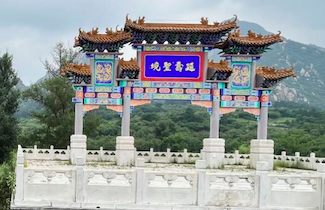
Cycle along Ansi Road, Wangbai Road, and Huaichang Road for about 14.8 kilometers until you arrive at the Yanshou Temple. You can take a rest at the "I Love Changping" Cyclists' Wooden House in front of the temple, and visit the temple.
Situated in Yanshou Town, Changping District, Yanshou Temple is renowned for its three treasures of strange pines, clear springs and pagodas. It is known as the "Holy Land of Longevity".
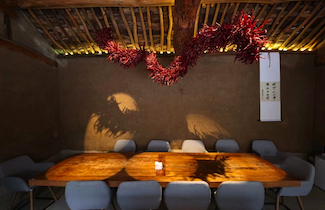
Riding down along the greenway from Yanshou Temple for over 1,000 meters, you will reach Beizhuang Village in Yanshou Town. The culturally distinctive Yanfangyuan Homestay Cluster in the village is the rest station for cyclists returning from the eastern route.
The cluster is an art-themed one integrating mountainside SPA Homestay, local specialty meals and a cycling-themed cafe. In addition to the eye-catching renovated small mountainside courtyards, it often joins hands with Xiayuan Artist Village to hold wonderful art and cultural activities.
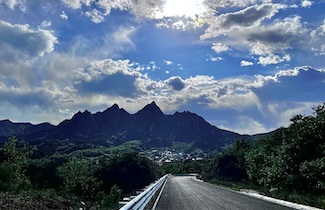
#
Go up along Huaichanglu for about 7.7 kilometers and turn back on Ansi Road. You will pass by the Cibeiyu Observation Deck. Riding along Ansi Road for about one kilometer to Wangbai Road, you will see the most stunning mountain scenery with rolling peaks in the distance and clean waters, soothed and relaxed.
- Cycling Route16 Introduction
- Cycling Route16 map
- Cycling Route16 route
- Cycling Route16 along
The Yongding River, known as the "Mother River" of Beijing, cradles the city with its pristine waters and nurtures a rich, long-standing civilization. Now, let's embark on a cycling journey along the long embankment of the Daxing section of the Yongding River, through a "healthy, fashionable, green, and low-carbon" travel way for the modern age.
All day
All day
Monday to Friday
09:00-16:00
Monday to Sunday
09:00-19:00
Monday to Sunday
09:00-18:00
Monday to Sunday
10:30-22:00
Monday to Sunday
08:30-18:00
All day
9:00-11:00
14:00-17:00
All day
09:00-21:00
All day

Planned route
Yongxing River Wetland Park - Traditional Chinese Medicine Cultural Park - Beijing Traditional Chinese Medicine Processing Technology Museum - Mifeng Wangguo (Bee Kingdom) Ecological Park - Tongrentang Zhima Jiankang No.0 Store - People's Commune Canteen - Yongding River Green Harbor - Zhugeying Folk Customs Village - Baojiapu Art Village - Cycling Park - Chaxiang Lishe - Wanmu Pear Orchard

Road condition
flat bicycle lanes alongside some countryside roads

Target groups
people of all age groups with their own bikes or shared bikes

Length
about 35 kilometers

Suggested time to finish
about eight hours

#
Located just outside the South 6th Ring Road in Daxing District, the Yongxing River Wetland Park is an expansive, open park perfect for cycling and walking. The park's most unique feature is its fusion of productive landscapes and greenway systems atop the ecological river landscape, creating a picturesque, ecologically rich, and interactive urban corridor.
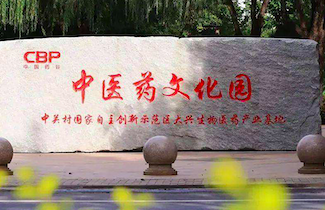
#
The Traditional Chinese Medicine Cultural Park offers an immersive experience into the history and culture of traditional Chinese medicine (TCM) with a relief wall, sculptures of renowned TCM figures, TCM story-themed sculptures, gardens of traditional Chinese medicinal materials, informative displays on TCM resources, a cultural square, and over 150 species of medicinal plants spread throughout the park. The cultural wall provides a snapshot of 5,000 years of TCM history, while the park's main path is lined with well-arranged landscaping and a diverse array of medicinal plants.
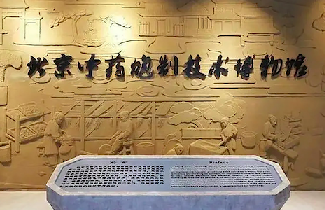
After departing the Traditional Chinese Medicine Cultural Park, cycle 0.7 kilometers southwards along Tianhua Street to reach Yongwang Road, then head westwards for 0.5 kilometers to arrive at Beijing Traditional Chinese Medicine Processing Technology Museum.
Also known as the "Jingbang Processing Museum", this institution is located on the first floor of the Huamiao Pharmaceutical research building. The museum showcases the deep-rooted legacies of TCM under four themes, namely "Historical Tracing", "Technology Inheritance", "Jingbang Collection" and "National Medicine's Illustrated Book". It also offers immersive experiences through touchscreen sand tables, slide rails, VR technology and other means.
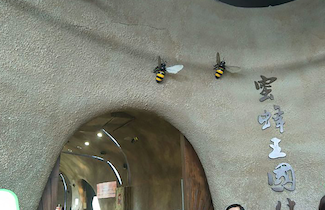
Leave Beijing Traditional Chinese Medicine Processing Technology Museum, go across the road, and you will arrive at the adjacent Mifeng Wangguo (Bee Kingdom) Ecological Park.
Mifeng Wangguo (Bee Kingdom) Ecological Park spans 2,080 square meters. Its planning process began in February 2014 and opened in December 2015 after 22 months of design and construction. Drawing on China's 3,000-year history of bee culture and the unique production resources of the production base of Bee Hall (a Beijing-based enterprise producing bee products), Mifeng Wangguo (Bee Kingdom) Ecological Park adheres to its mission of integrating tourism with industry, commerce, and culture. It highlights the wisdom of bees and the human appreciation for their roles in maintaining health through a natural way. The park consists of five sections, namely the Ecological Museum, Cultural Center, Tasting Hall, Bee Hall, and Health-keeping Hall.
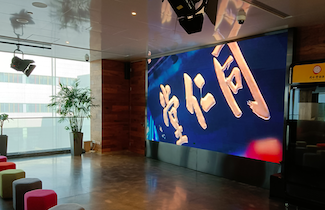
Leave Mifeng Wangguo (Bee Kingdom) Ecological Park, travel westwards along Yongwang Road for 1.3 kilometers to reach Luqiu Road, then head southwards for 1.6 kilometers, and you will find Tongrentang Zhima Jiankang No.0 Store.
Located in Daxing Biomedical Industry Base known as "Chinese Medicine Valley", Tongrentang Zhima Jiankang No.0 Store was established by blending traditional oriental culture and modern living concepts. The three-story "No.0 Store" houses a precision nutrition therapy section, a precise physiotherapy area, and a "treatment" area, offering visitors comprehensive anti-aging solutions, health-preserving diet plans, and personalized product packages based on their respective body types and the 24 solar terms.

Exit Tongrentang Zhima Jiankang No. 0 Store and head westwards on Weiyong Road for 3.8 kilometers to reach the People's Commune Canteen.
The People's Commune Canteen, situated at No.5 Weiyonglu in Daxing District, is a distinctive Northeast Chinese cuisine restaurant with a nostalgic design reflecting the 1950s and 1960s. The menu features both traditional healthy dishes and modern innovative creations, appealing to people of all generations. Though its name harks back to the past, the dishes cater to contemporary tastes.
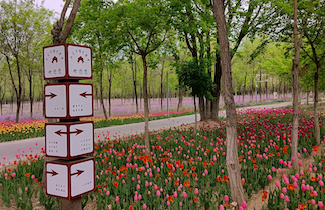
Leave the People's Commune Canteen, go westwards along Weiyonglu for 1.6 kilometers, then go southwards for 1.1 kilometers along Zuodi Road to reach Yongding River Green Harbor.
Yongding River Green Harbor is situated in Beizang Village, Daxing District. A total of 1 million tulips of 56 varieties symbolizing 56 ethnic groups in China cover an area of more than 20 mu (about 1.33 hectares) there. The park features a distinct landscape forest, a three-kilometer-long Begonia Avenue, a 10-kilometer-long looped cycling track, and a light show experience area in the central square, providing a haven for fitness, healthy cycling, and leisure activities for residents of Daxing District and southern Beijing.
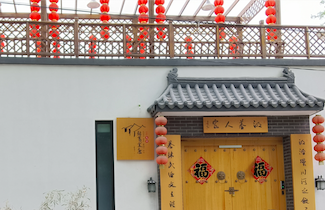
Leave Yongding River Green Harbor to go east, and you will arrive at the Zhugeying Folk Customs Village.
Zhugeying Folk Customs Village, located in Beizang Village, Daxing District, is currently focusing on developing folk custom-themed tourism activities and offers numerous Homestay featuring local customs, such as Zhuge Meilu Homestay and Danggui Courtyard.

Leave Zhugeying Folk Customs Village, go southwards along Xihanlu for two kilometers, and you will reach Baojiapu Art Village.
Baojiapu Art Village, situated in the northwest of Panggezhuang Town, Daxing District, is nestled between the Yongding River Irrigation Canal on the left and Xiwang Village and Liuminzhuang Village on the right. In order to establish the Baojiapu Art Village, the Daxing Photographers Association invited seven artists to join them. As you enter the village and follow the signs, you'll find a parking lot to your left and various sculptures lining both sides of the road. As you walk along the sculptures and pass the restroom, the No.1 Space Exhibition Area, open to the public, comes into view.
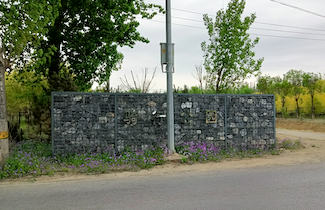
Leave Baojiapu Art Village, go southwards along Xihanlu for 4.6 kilometers, and you will reach Daxing Cycling Park.
The park is located in the west section of Fuyong Road, Daxing District. It's a cycling-themed park in the existing ecological forest.
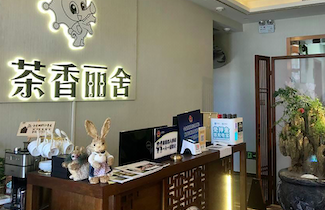
Leave Daxing Cycling Park, go southwards along Guanqu Road of Yongding River for 1.2 kilometers to reach Zhao'an Road, then go eastwards for 0.4 kilometers, and you will arrive at the Chaxiang Lishe Qingyouge Homestays.
At the intersection of Zhao'anlu and Zhaohanlu in Daxing District, Beijing, Chaxiang Lishe Qingyouge Homestay project spans a total area of 6,000 square meters. The project aims to develop homestay tourism through high-end boutique Homestay and hosting local events such as the Watermelon Music Festival, Pear Blossom Festival, and Watermelon-Themed Restaurant. With six homestays currently available, the project combines accommodations, natural scenery, countryside retreats, escape room activities, conference venues, party halls, farm estates, and children's playgrounds. Guests can enjoy attentive butler services, participate in activities, go fishing and barbecuing, relax in the forest, stroll along garden paths, pick their own fruits and vegetables, appreciate nature's beauty, and savor farm-to-table meals. The project's goal is to create a comprehensive tourism industry chain featuring dedicated services, winning public favor through reasonable prices, high-quality products, and excellent services. Bookings can be made through travel agencies, conference and exhibition companies, or online platforms.
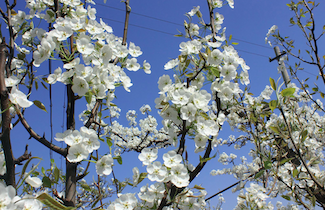
Leave Chaxiang Lishe Qingyouge Homestays, go southwards along Zhaohanlu for two kilometers to reach Xihanlu, go east for 1.2 kilometers, then go north for one kilometer, and you will see the Wanmu Pear Orchard.
Wanmu Pear Orchard, located in Lihua Village, Panggezhuang Town, Daxing District, has the largest cluster of ancient pear trees in Beijing. More than 30 varieties of delectable pears are planted in Lihua Village, with over 80 percent of the trees being over 100 years old and the oldest one being 410 years old. Visitors can enjoy blossoms in spring and picking fruits in autumn. Admission and parking are free of charge.
- Cycling Route17 Introduction
- Cycling Route17 map
- Cycling Route17 route
- Cycling Route17 along
This route goes among the mountains and rivers where the water merge with the sky in one color. Tourists can feel the perfect blend of the road and the scenery on both sides of the road. You can ride in full force to enjoy the traffic-free countryside, or stop by the beautiful Jinhai Lake to enjoy the beauty of the lake and mountains; or you can take a longer break to appreciate the perfect convergence of fashion and garden lifestyle. The flower sea, beautiful scenery, maple leaves, and fresh fruits of Pinggu will inundate the cyclists with so much fun.
Tuesdays-Sundays: 9:00-11:30 (last entry at 11:00); 14:00-17:00 (last entry at 16:30)
Closed on Mondays
All day
9:00-21:00 all the year round
9:00-21:00 all the year round
9:00-16:00 (Closed on Mondays)
March 15 - November 15: 8:30-17:30
9:00-21:00 (closed on Mondays)

Planned route
Pinggu Museum - Century Square - Jinhai Lake Scenic Area - Jinhai Lake H Life Experience Museum (Shantianxin Farm) - Shangzhai Culture Exhibition Hall - Huangcaowa Village - Wilderness 7 Daxishui Parent-child Camp - Bibo Island of Jinhai Lake

Road condition
gentle and wide road, and some sections of the road around the lake.

Target groups
all ages

Length
about 33 kilometers

Suggested time to finish
about eight hours (it is recommended to finish the trip in two days)
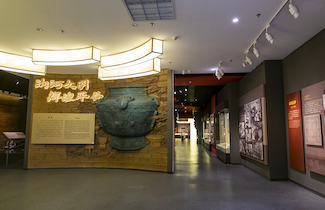
#
Pinggu Museum, located in the west of Pinggu Yingbin Roundabout, is a comprehensive venue integrating collection, storage, display, academic reports, science popularization and cultural exchanges. The museum comprehensively displays the long history and culture, glorious revolutionary tradition, unique folk culture, natural geography and various works of art in Pinggu District. There are four basic exhibitions, namely the "Pinggu History and Culture Exhibition", "Pinggu Folk Culture Exhibition", "Century Newspaper", and "Pinggu Planning", as well as two temporary exhibition halls.

The Century Square, 2.4 kilometers away from Pinggu Museum, covers an area of 200,000 square meters. This is where you can take a rest.
The Century Square covers an area of 200,000 square meters and has a beautiful environment. It is composed of leisure and entertainment areas and green areas, of which the green areas are 157,000 square meters, showing the excellent ecological environment of Pinggu and the beautiful scene of harmony between human and nature. The square is one of the main places for leisure and entertainment of Pinggu residents.

Riding 17.8 kilometers along the Xinping North Road and Shunping Road, you will reach Jinhai Lake Scenic Area, where you can enjoy the double fun of leisure and water.
The scenic area is located in Jinhaihu Town, Pinggu District, Beijing. It is a national AAAA-level scenic spot with a water area of 6.5 square kilometers. It is the largest comprehensive park for water leisure and entertainment in Beijing and has been rated as a municipal scenic spot and tourist resort. Jinhai Lake is surrounded by mountains on three sides, with beautiful scenery and dozens of landscapes such as the Huguang Pagoda, Tomb of Princess Jinhua, Wanghai Pavilion and Jagged Cliff, all of which resembles an integration of nature and humanity. The multiple options of water sports such as yachts, speedboats, bungee jumping, and sailing make it an ideal place for entertainment and vacation.
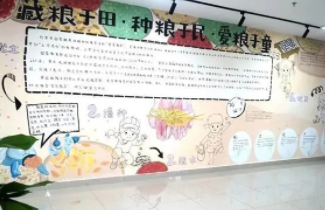
Out from Jinhai Lake Scenic Area and keep riding along the East Jinhai Road for one kilometer, to reach Jinhai Lake H Life Experience Hall, which is another place where you can take a break.
Jinhai Lake H Life Experience Hall is a core functional area built under Jinhai Lake H brand that integrates the three parts of Jinhai Lake Reception Room, Pinggu Tourist Service Center and the main post on the Juhe River and Ruhe River Economic Belt. The Hall has a total area of 5,600 square meters, with various leisure experience areas such as the book bar, coffee shop, Inch-wood Handicraft Workshop and children's cultural creation, creating a high-quality leisure and entertainment space for the visitors.

There is an agricultural leisure experience area (Shantianxin Farm) adjacent to the H Life Experience Hall.
Shantianxin Farm covers an area of 235 mu (38.68 acres), with agricultural classrooms, handicraft workshops, agricultural experience and family adopted vegetable fields as the four main parts. With the advantage of self-owned tourism resources, the farm operator combines agriculture, education, and tourism to create attractive agricultural programs featuring farmland protection, food education and farming experience, so that visitors can appreciate the countryside lifestyle in a happy and relaxed manner.

One kilometer away from Shantianxin Farm is the first Neolithic culture exhibition hall (Shangzhai Culture Exhibition Hall).
Pinggu Shangzhai Culture Exhibition Hall was built in 1987 and opened to public in 1989. It is the first special exhibition hall named after archaeological culture in China. It is also the first Neolithic culture exhibition hall in Beijing. The museum displays a wide array of cultural relics reflecting the life of the Neolithic human beings 7,000 years ago, filling the 2,000-year archaeological gap in the Neolithic Age in Beijing, presenting a historical picture with Shangzhai shining in the east and Zhoukoudian in the west.
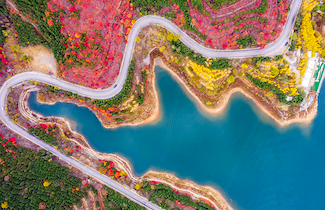
Departing from the Shangzhai Cultural Exhibition Hall, and keep riding along Pingji Road for four kilometers, you will reach Huangcaowa Village, a national key tourist village.
Huangcaowa Village, located in Jinhaihu Town, is a national key tourist village. It is close to the beautiful Jinhai Lake Scenic Area, surrounded by mountains and rivers, with beautiful scenery. The village has staggered springs and gurgling streams. The village has its head resting on the waves of Jinhai Lake and its back against a big mountain. The distinctive farmyards and country houses of different styles have attracted many tourists to stop by.
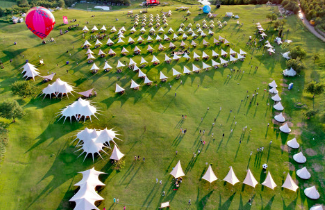
Continuing along Pingji Road for 4.6 kilometers, passing by Dongmagezhuang Village, turning right at the archway of Hongshikan Village, and riding along the path around the lake, you will reach the Wilderness 7 Daxishui Parent-child Camp.
Wilderness 7 Daxishui Parent-child Camp has a total lawn area of 240 mu (39.50 acres), of which 150,000 square meters is high-quality golf course lawn. Situated in a superb location, the Camp boasts sensational waves of lawns and mountainous landscape, the golden lake view and the historical Buddha Aura Pagoda. The beautiful sunset makes Daxishui an unparalleled landscape resource. In order to provide better and more diversified services, there is a service desk, a free parking lot that can accommodate 500 vehicles, coffee carts, dining carts and other camping gears.

Turn right from Daxishui Camp, and ride another 2.2 kilometers to arrive at Bibo Island of Jinhai Lake.
Bibo Island of Jinhai Lake is 85 kilometers away from the city of Beijing. It is the largest comprehensive landscape themed entertainment resort in Beijing, integrating accommodation, leisure, entertainment and outdoor experience. With the area of 22 square kilometers, the forest coverage rate is as high as 95 percent. The Island is surrounded by mountains and rivers, with birds singing and flowers blooming. The concentration of negative air ions is 2,067 per cubic centimeter, much higher than the WHO standard of 1500. As the largest natural oxygen bar in the Beijing-Tianjin-Hebei region, it is given the name of "Small Size Switzerland in the Suburbs of Beijing". There are complete reception facilities, including accommodation area, water sports area, children's entertainment area, and campsites. It is a good place to experience high-quality leisure lifestyle
- Cycling Route18 Introduction
- Cycling Route18 map
- Cycling Route18 route
- Cycling Route18 along
Huairou District is an important place to serve the functions of the capital and an ecological conservation area. With its high-quality natural environment and rich cultural and tourism resources, it is rated as the "Two Mountains" Practice and Innovation Base. It is also a national all-for-one tourism demonstration area.
The whole cycling route is about 40 kilometers, starting from the Yanqi Lake all the way to the west. Along the route, cyclists can appreciate both the charm of the international capital of conferences and the beauty of the lake and mountains. They can listen to the morning bell and evening drum and enjoy the beautiful scenery at the ancient Hongluo Temple. If they fancy some delicacies, they can taste delicious food in the private kitchen of Qunsheng Compound and sample Dashan coffee in Weidian Village. Once they arrive at the Lihua Streak Valley, they will have smile as sweet as the local chestnuts. By climbing onto the magnificent Great Wall, they can watch the beautiful scenery surrounded by mountains. A comfortable night stay in Huairou will give visitors the freedom to enjoy the poetic local lifestyle.
Finally, cyclists can finish the route by staying overnight in Beigou Village, "the most beautiful village in Beijing", to experience the unique day and night of the International Village at the foot of the Great Wall.
All the year round (may vary in winter based on the actual conditions)
Closed on Mondays
All the year round
All the year round
All the year round
All the year round
All the year round
Tuesdays-Sundays
(Closed on Mondays)
9:00-17:00
(Last entry at 16:30)
All the year round

Planned route
Yanqi Lake Scenic Area P7 Parking Lot (start point)—Yanqi Lake Road Dam Viewing Platform—Sunrise Kempinski Hotel—Yanqi Island—Yanqi Lake P9 Parking Lot—Hongluo Temple Scenic Area—Qunsheng Compound—Lihua Streak Valley—Qinran Dashan Coffee—Mutianyu Great Wall Scenic Area—Wa Art Architecture Museum—Beigou Village (finish point)

Road condition
The 40-kilometer route includes national highway, some village roads and some roads along the river, most of them being wide with beautiful environment.

Target groups
Yanqi Lake section: everyone The entire route: professional groups and young people

Length
about 40 kilometers

Suggested time to finish
Yanqi Lake section: about three hours The whole route: about six hours
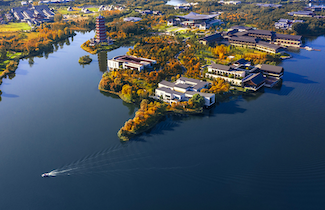
#
The Yanqi Lake is located on the edge of the Great Wall at the foot of Yanshan Mountain. Flocks of wild geese often come to live in the lake every spring and autumn, hence the name. The 2014 APEC Economic Leaders' Meeting and the 2017 Belt and Road Forum for International Cooperation were held here, and the Yanqi Lake became the focus of worldwide attention.
The Yanqi Lake has a flat terrain and broad water area, which is very suitable for various water and land entertainment projects. It is a famous tourist scenic spot and water park in the suburbs of Beijing. After the APEC meeting, a comprehensive guided tour system, slow-moving system and cycling system were built with the Yanqi Lake as the core in the area of 21 square kilometers. Sightseeing cars, shuttle buses and ferry boats are in place. Tourists can take a boat tour around the lake.

Going west along Yanqi Lake Road for two kilometers, you will arrive at the Yanqi Lake Road Dam Viewing Platform and Sunrise Kempinski Hotel, where you can enjoy the magnificent scenery of the Yanqi Lake.
The facade of the Sunrise Kempinski Hotel is a silver disc with 20 vertical ribs. The entire circular building stands over the Yanqi Lake, and the unique design of transparent glass curtain wall creates the illusion of "the sun rising from the lake". The shape of the silver disc inherits the Chinese philosophy of "oneness between humans and the universe". The circle expresses the idea of a balanced coexistence between humans and nature, at the same time embodying the theme of global cooperation and harmonious coexistence. In the early mornings, the sunrise shines brightly. At night the disc looks like a colorful moon above the water. The hotel has become a distinctive landmark in Huairou District.
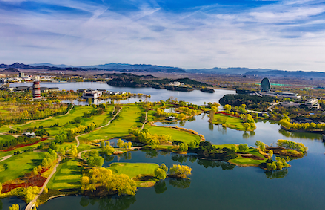
Continue to ride along Yanqi Lake Road and Fanqi Road for about six kilometers, to arrive at the P9 Parking Lot of Yanqi Lake. The scenery along the road is beautiful and the trees form thick shades. Visitors can have a grand view of the Yanqi Lake Convention and Exhibition Center, Yanqi Pagoda, and Yanqi Island from a distance.
The overall layout, landscape design and architectural appearance of the Yanqi Island fully reflect the styles of the Chinese imperial gardens and traditional architectures. At the same time, it also adopted the expressive techniques of modern architectures. The Yanqi Island covers an area of 650,000 square meters. The Yanqi Lake International Convention and Exhibition Center is the main architecture on the island and is the central stage for holding international political summits. The Yanqi Pagoda, designed by Ji Huai Road, a senior architect at the School of Construction of Tsinghua University, is the tallest building on the island, and is the sister tower of the Yongding Pagoda. The total height is 79 meters, with nine floors above the ground and two floors underground. The underground floors are used for storing equipment and as the underground palace respectively.
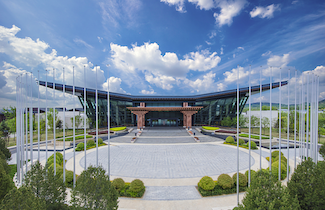
#
On May 4, 2016, the APEC Exhibition Center themed "International Capital of Conferences, the Mark of Glory - APEC Meeting in Huairou District in 2014" was opened to the public free of charge. Centering on the theme of "International Capital of Conferences, the Mark of Glory", the APEC Exhibition Center houses precious historical materials of the 2014 APEC meeting, showing the hard work of 380,000 Huairou people to build the capital of conferences, reproducing the splendid success of the APEC meeting in Huairou, and demonstrating the development achievements of the post-APEC era.
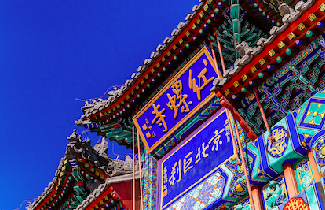
Turning back at the P9 Parking Lot of Yanqi Lake, ride along Fanqi Road (downward road) and Hongluo Road for eight kilometers to reach the Hongluo Temple Scenic Area, famous for the imperial bamboo forest, male and female ginkgo biloba, and wisteria pines.
The Hongluo Temple was first built in the fourth year of Xiankang in the Eastern Jin Dynasty (AD 338). As the saying goes, "there is Putuo in the south and Hongluo in the north". The thousand-year-old temple has its back against the majestic Hongluo Mountain in the north and faces the beautiful Hongluo Lake in the south. The temple is surrounded by tall ancient trees. The "Three Wonderful Sceneries of Hongluo Temple" – the imperial bamboo forest, male and female ginkgo biloba, and wisteria pines are dotted inside and outside the temple. Millions of green bamboos and more than a thousand acres of ancient pines embrace the whole temple, forming a beautiful scroll of "ancient temple hidden in the green".

Riding along Hongluosi Road, Bachang Road, and Huaihuang Road for about four kilometers, you will arrive at the Internet-popular restaurant Qunsheng Compound, which has been included on the must-eat list of Dianping many years in a row.
The Qunsheng Compound is located at No.22, Xisan Village, Huairou District. It is a catering brand that specializes in traditional Beijing sauced donkey meat with an inheritance of 200-year history of Dongba donkey meat. The restaurant, built in the form of a compound, is the place where Peking Opera, the donkey culture, and Mu Xin's poetry converge. It is a leisure and entertainment space where visitors can appreciate culture and food at the same time.
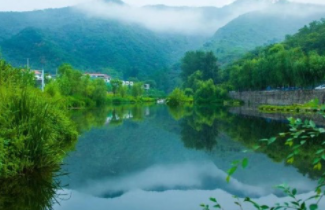
Riding along Huaihuang Road for about six kilometers, you will arrive at Sanduhe Village, Bohai Town, which is the entrance of the Lihua Streak Valley. Keep riding along Bosan Road to Liuduhe Village. This section of the route is winding and secluded, with beautiful mountains and clear waters.
The Lihua Streak Valley (formerly called Lihuagou) starts from Sanduhe Village in the south and ends at Baduheling Village in the north. There is an 8.1-kilometer span of wetland park along the way. The place got its name for abundant chestnut trees, green mountains and clear waters, and is the key valley-themed leisure tourism destination in Bohai Town, as well as one of the most important ecological valley construction projects in the region.
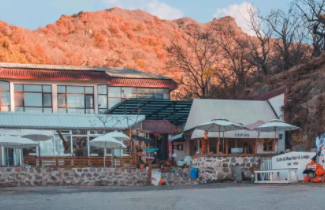
Turn back along Bosan Road, and ride along Huaihuang Road all the way to the west for about seven kilometers to arrive at the Qinran Dashan Coffee in Weidian Village.
The Qinran Dashan Café is located in a small corner in the mountainous area in Weidian Village, Huairou District. There is no traffic noise, or impetuous colorful lights, but only simple small cottages with wooden doors and windows, and stretches of walnut trees and mountains...
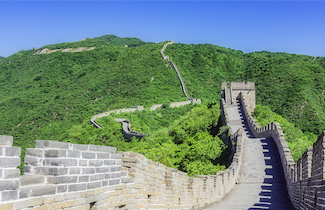
Continuing to ride along Huaihuang Road for 2.5 kilometers to the Mutianyu Roundabout, you will arrive at the Mutianyu Great Wall Scenic Area.
The Mutianyu Great Wall, located in Huairou District, is one of the best sections of the Ming Dynasty Great Wall. Its architectural design, such as the Central Gate Tower composed of three enemy-monitoring towers, Giant Corner Tower, double-sided crenels, and drainage channel of the horseway, is unique in the Great Wall. The three-dimensional effect of the Mutianyu Great Wall and the coexistence of internal and external branches also reflect the highest artistic achievement of the Great Wall construction in the Ming Dynasty.
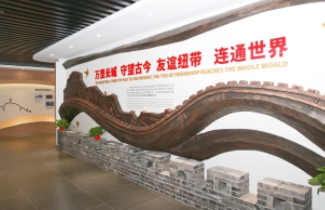
#
The "Great Wall Spirit" Exhibition Hall of two floors, with the theme of "Great Wall Spirit, a Peace Bond and World Bridge", consists of nine sections, including the Watching Peace, Centennial Glory, and Red Memory, etc. The Great Wall serves as an important carrier to demonstrate our patriotic spirit, national spirit, and peace spirit to the world. It also shows the Chinese people's good wishes for peace and our vision to carry out practical activities of building a community with a shared future for mankind together with the world.

Riding along Huaihuang Road and Xintao Road for about 2.6 kilometers, you will arrive at the Wa Art Architecture Museum, as well as the Beigou International Cultural Village, the final stop of this ride.
The Wa Art Architecture Museum is located in Beigou Village, Huairou District. The red brick walls and the golden glazed tiles are the biggest highlights of the museum. There are three themed spaces, namely the Memory of Beigou, Present of Beigou and Future of Beigou. The Wa Art Architecture Museum was established to develop and revitalize the countryside, highlighting an attitude that integrates the image of the countryside with the aesthetics of the city.

#
Beigou Village, located in Bohai Town, Huairou District, is clean and tidy, with a beautiful environment. It not only provides a comfortable living environment for the villagers, but also attracts "foreign phoenixes" here. 12 foreign tenants rented limited houses from the villagers and renovated the properties themselves, adding 12 unique and characteristic small courtyards to Beigou Village. These courtyards complement Beigou's green and the majestic Great Wall, adding a touch of exoticism to Beigou's beauty.
- Cycling Route19 Introduction
- Cycling Route19 map
- Cycling Route19 route
- Cycling Route19 along
Miyun Reservoir is an important source of surface drinking water in Beijing, a strategic water reserve base, as well as a beautiful ecological symbol of the capital of China.
The circular road surrounding the reservoir, with a total length of about 100 kilometers, is an important section of the roads around the reservoir. It was built at the same time as Miyun Reservoir, connecting seven towns, 19 folk villages, 12 scenic spots, five-starred hotels, two boutique countryside hotels and 57 boutique homestays.
The "Southern Reservoir Highway" section of the circular road won the title of "Top Ten Most Beautiful Rural Roads", an award issued by the Ministry of Transport of the People's Republic of China in 2021.
Opening hours:
8:30-17:00
Cable cars:
8:30-16:30
All day
9:30 to 17:00
Monday – Friday:
8:30-17:30
Weekends & statutory holidays: 8:00-18:00
Mondays to Fridays:
9:00-17:00
Weekends/statutory holidays: 8:30-17:00
All day

Planned route
Yunfo Mountain Ski Resort - Miyun Yujie (Miyun Fish Street) - Yunmeng Mountain Scenic Area - Bulaotun Observatory - Yishi Manor in Songshugu Scenic Area - Sunshine Valley

Road condition
Most of the road sections are flat and smooth, and some sections have relatively steep slopes.

Target groups
A must-go route for professional cyclists and a place for leisure riding tours, meeting the riding needs of various groups.

Length
about 100 kilometers

Suggested time to finish
For professional cyclists, it generally takes three to five hours to complete the whole journey. Leisure cyclists are recommended to arrange their riding plan and accommodation according to their own circumstances. It is recommended to complete the whole journey in one or two days.
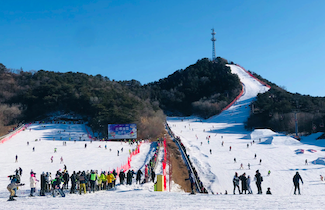
Distance to the next destination (Miyun Yujie): 1.4 kilometers
Yunfo Mountain Ski Resort, located in Xiwengzhuang Town, Miyun District, is a large-scale comprehensive ski resort integrating functions of accommodation, catering, conferences and entertainment. It covers a total area of 450,000 square meters, with broad snow tracks and a complete variety of facilities.
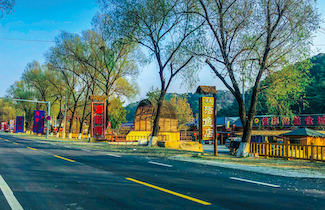
Distance to the next destination (Yunmeng Mountain Scenic Area): 12.7 kilometers
Miyun Yujie (Miyun Fish Street) has a total length of 3.8 kilometers. There are currently more than 30 gourmet restaurants, which can cater to more than 7,000 people at the same time. As the most famous gourmet street in Miyun, it has gathered all the best practices for cooking fish after more than a decade's development. Each restaurant has its unique way of cooking fish. The street is a fish-themed leisure place integrating catering, accommodation and entertainment facilities.

Distance to the next destination (Bulaotun Observatory): 26.5 kilometers
Yunmeng Mountain Scenic Area, located in the west of Miyun, is a famous natural scenic area in the suburbs of Beijing. Its total area is 2,208 hectares. The main peak of Yunmeng Mountain is 1,414 meters above sea level. The area is rich in landscape resources, and is famous for the beautiful mountain views. It has the reputation of "Little Mount Huangshan" in northern China.
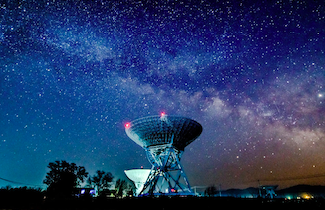
Distance to the next destination (Songshugu Scenic Area): 30.9 kilometers
Bulaotun Observatory is located on the northern bank of Miyun Reservoir. Constructed in 1966 following approval, it is the main observation base for radio astronomy in China in the early days. It is one of the important observation bases of the National Astronomical Observation Center of the Chinese Academy of Sciences. The 50-meter antenna at the observatory is currently the largest in China.
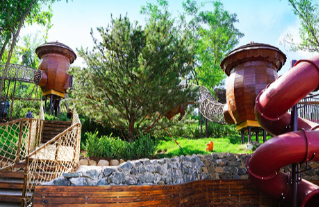
Distance to the next destination (Yishi Manor): 5.1 kilometers
Songshugu Scenic Area is the first squirrel-themed parent-child park in northern China. The entire area consists of five major sections, namely the "Squirrel Paradise", a high-end homestay, an ecological restaurant, Starry Sky Cafe, and the Mountaintop Infinite Pool. There are more than 2,000 squirrels of different species in the park. It is a tourist resort integrating providing services related to parent-child interaction, leisure and vacation, and nature education.
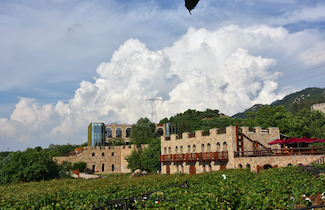
Distance to the next destination (Sunshine Valley): 19.2 kilometers
Yishi Manor International Winery is located in Taishitun Town, Miyun District, and adjacent to Miyun Reservoir. The manor covers an area of 1,260 mu (84 hectares). Built in 2000, it is a combination of an European-style castle and a Chinese-style building, integrating natural, historical and cultural elements as well as classical art. It is an ideal choice for wedding photography, family travel, business meetings, and leisure vacations.
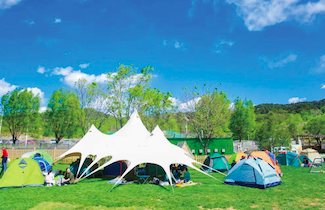
#
Sunshine Valley, located in Gelaoyu Village, Mujiayu Town, Miyun District, Beijing, is a camping park with the theme of leisure and vacation, funded by Sunarea Group. Covering a total area of 825 mu (55 hectares), the park offers various vacation experiences such as camping, parent-child entertainment, happy farm, gourmet, outdoor sports, etc.
- Cycling Route20 Introduction
- Cycling Route20 map
- Cycling Route20 route
- Cycling Route20 along
Yanqing District is situated at the foot of the Great Wall, on the banks of the Guihe River. As one of the first demonstration areas of all-for-one tourism in China, Yanqing is known as the summer capital of Beijing. The International Horticultural Exposition 2019 Beijing China was held here. It is also one of the venues for the 2022 Beijing Winter Olympics and Paralympics.
Yanqing is the first area in Beijing to be awarded the title of "China's Natural Oxygen Bar". The air quality is excellent, and the ecological environment is beautiful. The annual average concentration of negative air ions is 2016 per cubic meter.
The Guihe River is the mother river of Yanqing, which has given birth to the beautiful sceneries of the four seasons. In spring, you can enjoy the full sky of flying flower petals. In summer, you can avoid the scorching heat. In autumn, you can enjoy the fun of picking fruits and vegetables. In winter, you can appreciate the beauty of Haituo Mountain covered in snow from a distance.
Monday-Thursday 9:00-17:00;
Friday-Sunday & statutory holidays 9:00-21:00
All day
09:00-16:00
All day

Planned route
Beijing Expo Park - Guihe Forest Park (Daying Beacon Tower) – International Grape Exhibition Garden - Banquan Sports Park (Landscape Rice Fields, Xiabanquan Beacon Tower Ruins)

Road condition
including a small section of mixed traffic; dedicated bicycle lanes available in the Guihe Forest Park and Banquan Sports Park

Target groups
all ages with their own bikes or rental bikes

Length
about 45 kilometers

Suggested time to finish
about seven hours
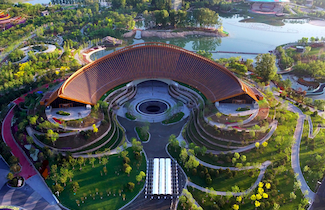
The Beijing Expo Park is the venue for the International Horticultural Exposition 2019 Beijing. It is now a national AAAA-level scenic spot with an area of 503 hectares.
With the Beijing International Garden Festival and the Ice and Snow Carnival as the focus, the Park hosts a series of special activities such as research, cultural education, music, sports, and camping throughout the year. It is a place worthy of your visit all the year round. It has a complete tourism ecology and a nearly perfect environment for fitness and health preservation. Whether it is for vacation, a walking tour, or aerobic jogging, the mature "urban park" can well meet the needs of visitors and create a perfect cycling space for the majority of cycling enthusiasts.
Cycling activities are held in the park every week, from 7:00 to 9:00, and from 17:00 to 20:00, Monday to Friday (except statutory holidays); and from 7:00 to 9:00, and from 18:00 to 21:00, Saturdays and Sundays (including statutory holidays). Visitors can sign up by following the WeChat Official Account "Beijing Expo Park".
Both the Hyatt Hotel and Tangquan Hotel are adjacent to the start point of this cycling route. You have the opportunity to see the beautiful scenery of the Beijing Expo Park from the hotel room.
l Recommended accommodation: Hyatt Regency Beijing Shiyuan
Yanqing's mountains, river, flowers, and birds as the main elements of the design inspiration of Hyatt Regency Beijing Shiyuan. These elements are integrated into every design detail of the hotel. The conference center designed in a modern style and the green lawn provide you with space for business and leisure. The Chinese and Western specialty restaurants satisfy your cravings for gourmet. With the hotel's relaxing vacation environment, considerate services, perfect integration of nature and technology, whether you are here to spend some time alone or with your family, you will find peace for the body and soul.
l Recommended accommodation: Shiyuan Tangquan Hotel
The Shiyuan Tangquan Hotel, on the opposite side of the Beijing Expo Park, has a total of 108 room in four types: Premium View Room with Private Hot Spring, Selected Room with Private Hot Spring, Deluxe King Room and Ordinary Room. The hotel boasts a perfect combination of sensory experience and pleasant atmosphere. The place is interesting and refreshing, allowing visitors to have a total recovery of energy at night after a whole day's fun. It is definitely an ideal choice not to be missed.
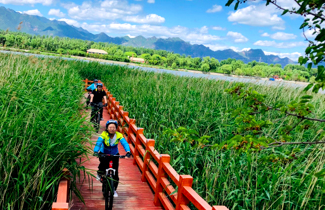
Starting from the Beijing Expo Park, ride along Baikanglu and Huanhunanlu for about five kilometers to arrive at the Guihe Forest Park.
The Guihe Forest Park is one of the 11 new urban riverside forest parks in Beijing, which integrates ecological conservation, tourism, vacation and leisure. There are bicycle lanes and a complete slow-moving system, a simple yet beautiful square, and a tourist service center with complete facilities. The Park is full of elegant pavilions, corridors, flower stands and other garden sketches. The Park's beauty lies in its complete range of hills, rocks, forests, water, flowers, and grasses, and its elegance lies in its combination of clearness, seclusion, tranquility, and wilderness.
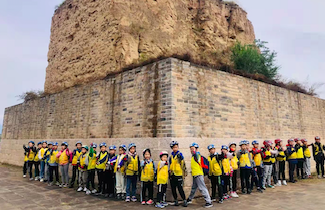
#
The Daying Beacon Tower, commonly known as the "Giant Tower" or "Giant Ancient Tower", is located in the Guihe Forest Park. This place used to be a military camp, and the nearby Daying Village was named after it. According to the records of relevant local chronicles, this beacon tower was supposedly built in the mid-and late Ming Dynasty. Due to its large scale and priority, the tower, together with other fortresses such as the Juyongguan, Badaling, Chadao, Yanqing, and Yongning constitutes a deep defense system for the north of the Great Wall in the Ming Dynasty. If you ride here, you can feel the vicissitudes of the Daying Beacon Tower. You can also overlook the Yongning Pavilion of the Beijing Expo Park.

B&B is one of Yanqing's characteristics. The boutique Horticultural Homestay is less than three kilometers away from the Guihe Forest Park.
The Horticultural Homestay, located in Huoshaoying Village, Kangzhuang Town, Yanqing District, is home to 10 courtyards, which can accommodate about 150 people at the same time. There are facilities such as shared farm, academy, restaurants, chess & card room, Zen room, cafés, calligraphy & painting academy, conference rooms, and several tea rooms. It is a boutique homestay featuring original ecological agricultural tourism and cultural leisure that integrates tourism, agricultural efficiency, optimization of the ecological environment and social & cultural functions.
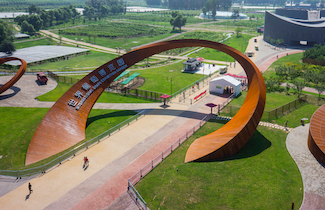
Continuing along Huanhunanlu and Kangzhanglu, passing by the Guanting Bridge and Yanxialu, and riding for about four kilometers, you will reach the International Grape Exhibition Garden.
The International Grape Exhibition Garden is the venue for the 2014 International Grape Conference and is currently the largest grape-themed park in China. It integrates the functions of grape variety display, viewing and picking, ecological experience, scenic spot tour, science education, leisure and entertainment, etc. It is a national AAAA-level tourist spot, a science popularization base, a social classroom unit for elementary and middle school students in Beijing, a five-star national leisure agriculture and rural tourism park, and a national youth outdoor camp. There are regular activities such as parent-child camps and model airplane competitions. A three-kilometer cycling lane is in place where visitors can enjoy the wetland landscape of Caijiahe River and fruitful grape racks, and feel the fresh air of the International Grape Exhibition Garden.

The Great Hide-out Town is less than four kilometers away from the International Grape Exhibition Garden. This section of the road is flat and smooth. You are recommended to experience the unusual homestay here.
There are 20 B&Bs in the Great Hide-out Town, including 12 uniquely designed B&Bs, five designer B&Bs and three villas. All of the B&Bs are within 10 minutes of walk and are fully equipped with air-conditioning and floor heating. The courtyards are furnished in a warm and cozy style. There are highlights such as the ins-style swimming pool, gorgeous romantic villa, minimalist style B&B, garden style farmhouse, etc. Guests can swim, sing karaoke, and have a barbecue party, or have dinner under the starry sky, or interact with the cats under the umbrella chair. Each style offers a different life experience.

Continue to ride along Shipuyuanlu and bypass of Shipuyuanlu for about three kilometers, to arrive at the Banquan Sports Park.
The Beijing Yanqing Banquan Sports Park is located in the 10,000-acre afforestation area of Caijiahe Village, Zhangshanying Town, Yanqing District. The forest coverage rate in the park is nearly 100 percent. There are five-kilometer and ten-kilometer cycling tracks and a 28,000-sqm cross-country cycling field. It is therefore chosen as "the Cycling Training Base" by the Beijing Cycling Association. It is also a national youth camp. The park has a three-level slow moving system, including comprehensive roads, bicycle lanes and pedestrian lanes. Forest greenways, idyllic scenery, landscape water systems, and beacon tower ruins are intertwined. The park can provide venues for various extreme sports, accommodating the different needs of the tourists.

It is located inside the Banquan Sports Park.
The Landscape Rice Fields cover an area of 50 mu (8.23 acres). It is located inside the Banquan Sports Park and is a must-see trendy attraction in the park. In autumn, the fields become a golden sea with the fragrance of rice. There are wooden planks in the field for tourists to walk on. Other landscape sketches such as the big windmills form a poetic scene in an oil painting.
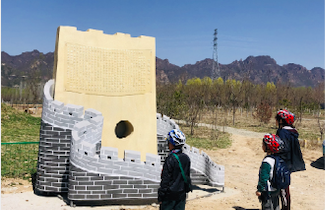
#
The Xiabanquan Beacon Tower, historically known as the "Xiabanqiao Tower", is located inside the Banquan Sports Park. It serves as a road pier in the defense system of the Great Wall in the Ming Dynasty. It is situated about five kilometers away from Yanqing City next to the "Banquan Path", a road heading toward the ancient northwestern silk road, guarding "Banqiao". The beacon tower is tall and large, and has a stone base, a rammed earth core, and a brick exterior. It is divided into upper and lower floors. There is an arch gate in the east of the building, with a passage to the roof. There are watchtowers on the upper floor, surrounded by crenels. The tower is surrounded by walls. The barracks are equipped with gates and wells, which are used for defense and intelligence information communication. Together with the Shangbanqiao Tower and Zhangshanying Tower, it constitutes the military information communication and defense system in the northwest direction of Yanqing City.
- Cycling Route21 Introduction
- Cycling Route21 map
- Cycling Route21 route
- Cycling Route21 along
The cycling route featuring the Beijing Economic-Technological Development Area (BDA) is designed centering around the green Yicheng, International Enterprise Avenue, and some characteristic business districts. The start point is in the East Park of the Intl. Corporate Culture Park. With a total length of 30 kilometers, it goes along Ronghuabeilu toward the south to Ronghuazhonglu, with the commercial district of Libao Plaza on the east side.
Going toward the west along Tianhuabeilu, and turning left at Tianhuadonglu, you will enter the Maple Boulevard, a street full of maple trees. Here you can enjoy the scenery of red maple leaves swaying in the wind in early autumn. On the west side of the slow road, you will pass by residential communities such as Yidongyangfang, Luming Garden, the sports and leisure area of Boda Park, and Chaolin Songyuan Hotel with a super five-star standard. Cyclists can feel the comfort of the living environment in the BDA where the residents have the scenery at their doorsteps.
Go south along Ronghuananlu, and you will pass by the Han's Plaza commercial area on the east side, where you can stop for a break.
Ride along the route of Yizhuang T1 Line (YZ T1 for short), you can "race" against the T1 trains to feel the advancement and convenience of the public transportation networks in the BDA. You will pass by the Beijing Benz, where you will be amazed by the enormous volume of the automobile manufacturing industry. Cycle to the Liangshuihe Park, and go east along Liangshuihe slow way to Tongming Lake Park, to feel the vitality of the City Park of Yizhuang International New Town.
Riding along Tonghuiganqudao, Kechuangshierjie, and Kangdinglu, you will pass by many well-known companies such as the Unistrong, Jingdong, ABB, etc. Here you can feel the vitality and charm of the integration of industry and the city. Continuing riding toward north along Hongdalu, you can watch the violet paulownia flowers blooming in spring, and feel the dreamy scenery of this trendy site. Finally, you will return to the start point in the East Park of the Intl. Corporate Culture Park.
Monday-Sunday
09:00-17:00
Monday-Sunday 10:00-21:30
Monday-Sunday
All day
Monday-Sunday 10:00-22:00
Monday-Sunday 06:00-22:00
Monday-Sunday
All day
Monday-Sunday
All day

Planned route
Intl. Corporate Culture Park - Libao Plaza - Maple Boulevard - Boda Park - Chaolin Songyuan Hotel – Han's Plaza – YZ T1 - Beijing Benz - Liangshuihe Park - Tongming Lake Park - Paulownia Boulevard

Road condition
gently bicycle lanes

Target groups
all ages

Length
30 kilometers in total

Suggested time to finish
about five hours
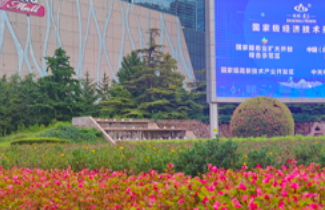
Riding south along Ronghuabeilu for about one kilometer, you will arrive at the Libao Plaza on Ronghuazhonglu.
The Libao Plaza is located at the southeast corner of the intersection of Ronghuazhonglu and North Ring Middle Road, BDA, Daxing District, Beijing. Building A of the Plaza is 80 meters high and has a construction area of 19,000 sqm. It is a large international building complex.
The Plaza is intended as an AAAAA-level international business platform that covers all kinds of world commodities and business services.
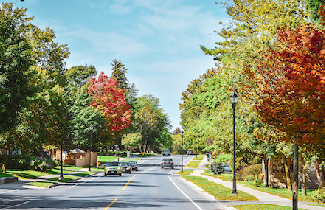
Keep riding south along Ronghuazhonglu for about 400 meters, turn west at the intersection to enter Tianhuabeijie, go west along Tianhuabeijie to Tianhuadonglu, and turn south to enter the Maple Boulevard.
The Maple Boulevard is full of maple trees on both sides of the road that extend along the road. When the leaves on the trees are almost all yellow, and the sunlight penetrates through the orange leaves, making the whole street colored in a soft tone.

Riding along Tianhuananjie for about 500 meters to Kehuidadao, you will arrive at the Boda Park.
The Boda Park is designed following three principles: 1) The ecology must be given higher priority. Through the construction of the park, the quality of the area is improved. With the plant landscape in place, the ecology in the park achieves natural circulation; 2) Resources must be utilized in an intensive manner. Environmentally friendly and energy-saving construction facilities and equipment have been used to save energy, water, and materials; 3) The benefits of all aspects must be balanced. That is to say, the ecological benefit, social benefit, and technological benefit must be well balanced.
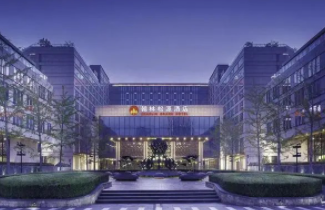
Ride along Kehuidadao, and you will pass by the super five-star Chaolin Songyuan Hotel on the way.
The Chaolin Songyuan Hotel, located in the core business district of BDA, is the only state-level development zone in Beijing. It is adjacent to the Boda Park, the "green lungs" of the BDA, and is only two kilometers away from the Nanhaizi Park, which is the best wetland park in Beijing. It is a perfect choice for business meetings and vacations.
The hotel is a luxury business hotel built with a super five-star standard. The overall style is noble, elegant, magnificent and exquisite. The hotel has a collection of more than one hundred authentic oil paintings created by international famous masters, and has a special collection version of the "Golden Elm Emerald" piano which was made for the 135th anniversary of Steinway. Many ingenious art treasures bring a gluttonous art feast to the guests.
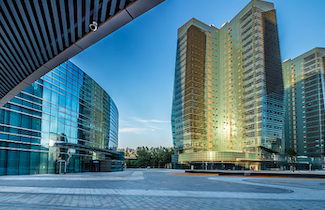
Riding south along Ronghualu for one kilometer, you will arrive at the Han's Plaza.
The Han's Plaza is located in the core of the BDA, and is only one step away from the Rongjingdongjie light rail station. It is at the intersection of the core roads and the key bus station in the BDA. At the same time, it is an office building built above two subway lines, which is very scarce in Yizhuang. Yizhuang Line and Line L5 are the two key subway lines in southern Beijing. They will bring easier and more convenient commuting for the employees working at the Plaza and more efficient business experience for the corporate tenants.
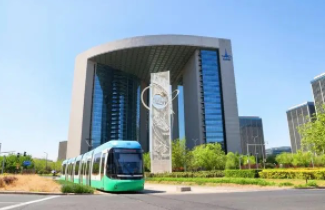
Ride toward the south along Ronghuananlu for about 1.6 kilometers to arrive at the roundabout of YZ T1.
The YZ T1 (Laoguanli - Dinghaiyuan) is a tram line with a total length of 13.25 kilometers and a total of 15 stations, all of which are above the ground. On December 31, the section from Quzhuang to Dinghaiyuan was open, with a length of 11.9 kilometers and a total of 14 stations. The opening of Laoguanli Station was postponed. The hubs of the YZ T1, light rail Yizhuang Line, and 12 bus lines in the BDA make the transfer easy and connect the four major functional areas of the BDA, namely the Core Area, Hexi Area, Lunan Area and Ludong Area. The possibility of connecting with the planned Line S6 is reserved.

Riding toward southwest along Rongchangxijie and continuing to ride southwest after entering Boxinglu for about 3.3 kilometers, you will arrive at the Beijing Benz Automobile Co., Ltd.
The Beijing Benz Automotive Co., Ltd. (BBAC for short) is a joint venture between BAIC Group, Daimler AG and Daimler Northeast Asia Investment Co., Ltd. established on August 8, 2005. BBAC's new factory is located in the BDA, with an annual production capacity of 100,000 vehicles. As the most advanced world-class automobile manufacturing enterprise in China, BBAC has defined a new benchmark for modern automobile enterprises with its five-day features.
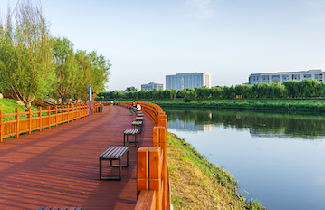
Turn back from the Beijing Benz Automobile Co., Ltd., and ride northeast along Boxinglu for about 2.2 kilometers, to reach the Liangshuihe Park.
The Liangshuihe Riverside Park is a fully open public green space. The design of garden sketches, garden roads, and green landscape is a name card which shows the image of the public environment of the town. The park is built to meet the needs of the local residents for outdoor activities such as fitness and leisure, entertainment and communication, sightseeing, etc.
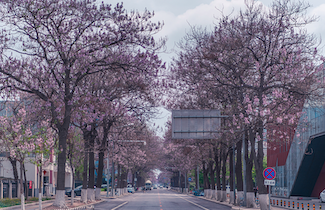
Starting from the Tongming Lake Park, riding northeast along Tonghuiganqulu for about 1.2 kilometers to Kechuangshierjie, riding toward west along Kechuangshierjie to enter Kangdinglu, and continuing to ride westward along Kangdinglu for about 4.4 kilometers to Hongdalu, you will be able to appreciate the dreamy beauty of the "Paulownia Boulevard" along Hongdalu all the way to the north.
Paulownia flowers are the flowers of Paulownia and Paulownia tomentosa of Scrophulariaceae plants. It is large arbor that can grow up to 30 meters tall. Paulownia is a fast-blooming tree. Every March to May, the tall and straight paulownia trees on the "Paulownia Boulevard" will bloom violet and pink-white flowers clustered on the crown of the tree.